The next day, after falling asleep to it being warm and sunny, turned out to be cold and cloudy. I really can't remember what time I woke up; time has little meaning in the circle where it's always daylight. It really starts to screw with your body clock, but in a way is very freeing. It's yet another restriction that you find yourself free from.
I kept going north, and it was getting cooler and more humid. I was in a valley for most of the day, and the clouds would get stuck on the leeward side of the mountains.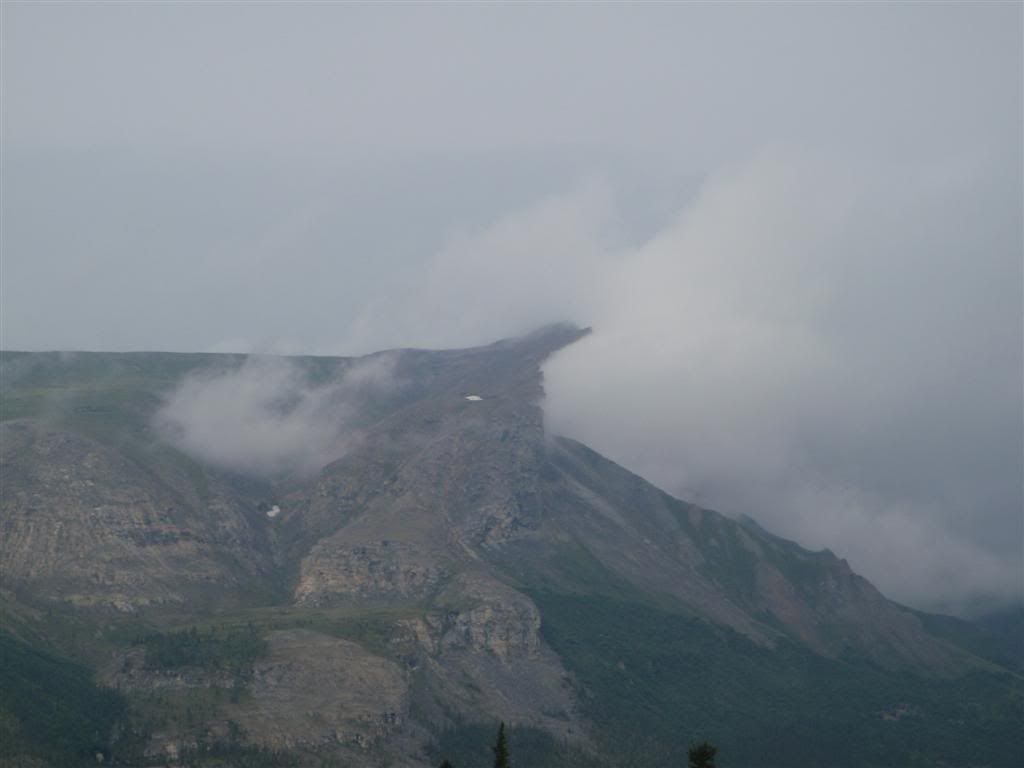
As I got farther north, higher altitude and closer to the Atigun pass over the middle of the Brooks range, there was evidence of recent rains. The road was still a lot of clay and there was enough gravel to provide decent traction for most of it, but the fifth-gear, 45mph+ times of the past few days were gone. 25mph was a good speed in these conditions, sometimes slower when it looked like it might get really sloppy.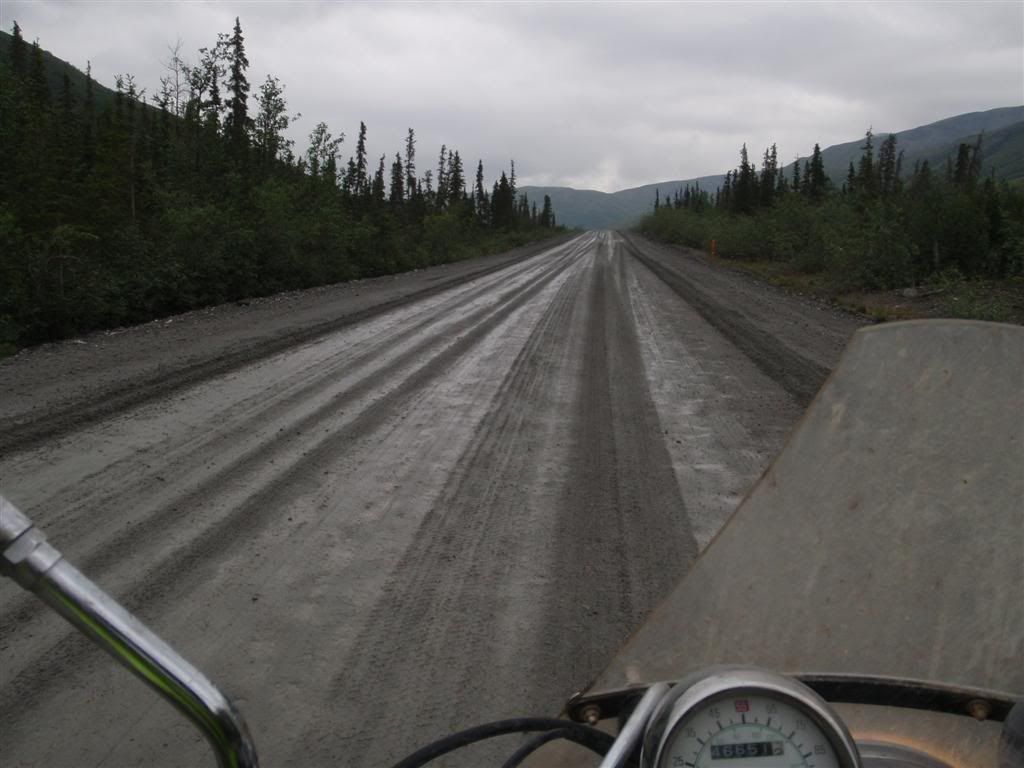
It was getting quite cool, 50 degrees or so, and damp. There's ice here that only melts just before the fall snows start, and as I got higher in the mountains, there was more and more of it around. At this point, I was very much missing my winter gloves.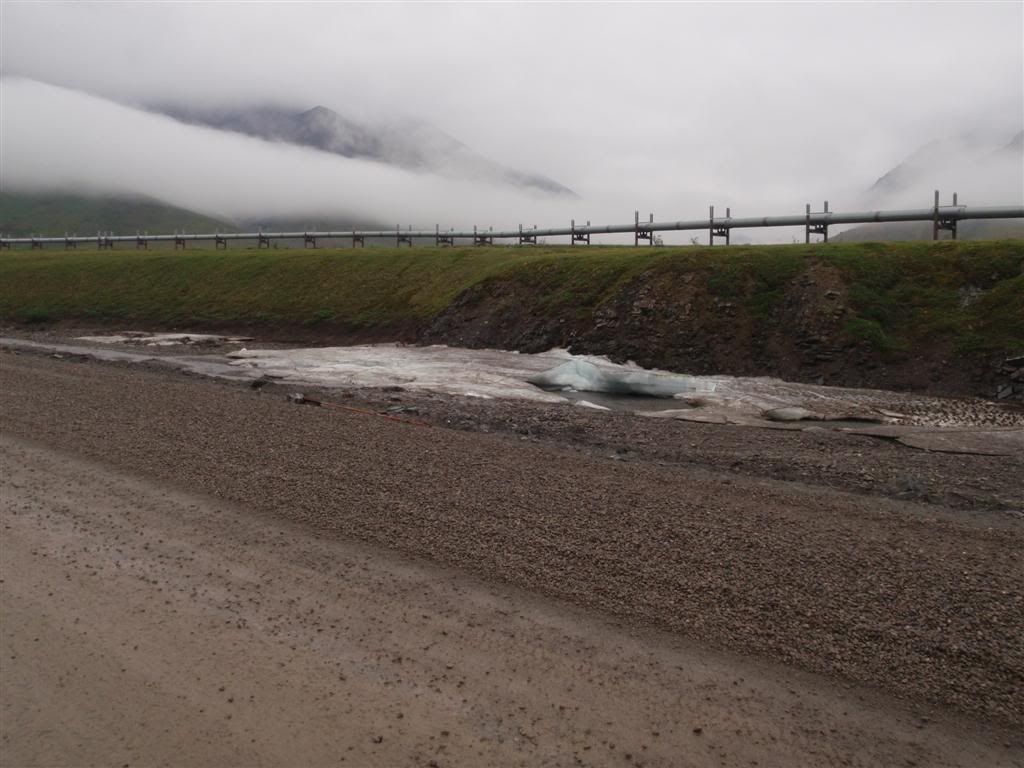
A few hours into the day, and I made it to the Atigun pass, where the road does an absurd amount of climbing in a very short period of time before it crests the Brooks Range and starts heading down to the North slope. 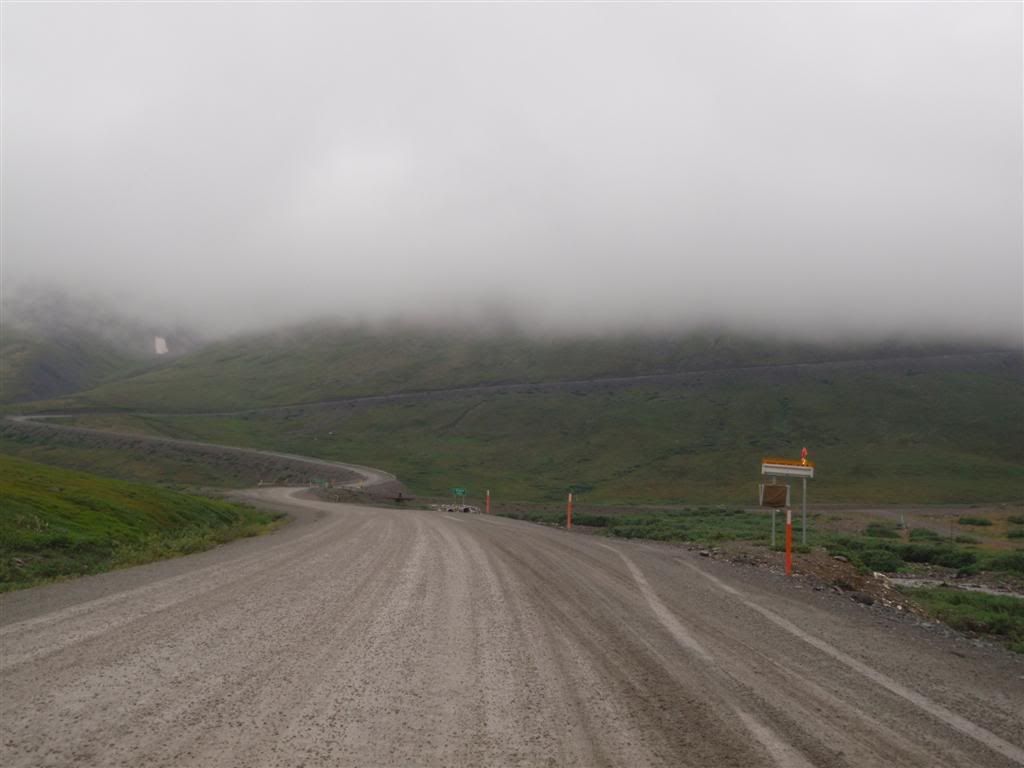
Up and up I went, into the clouds, cresting the pass and heading down the other side of the mountains.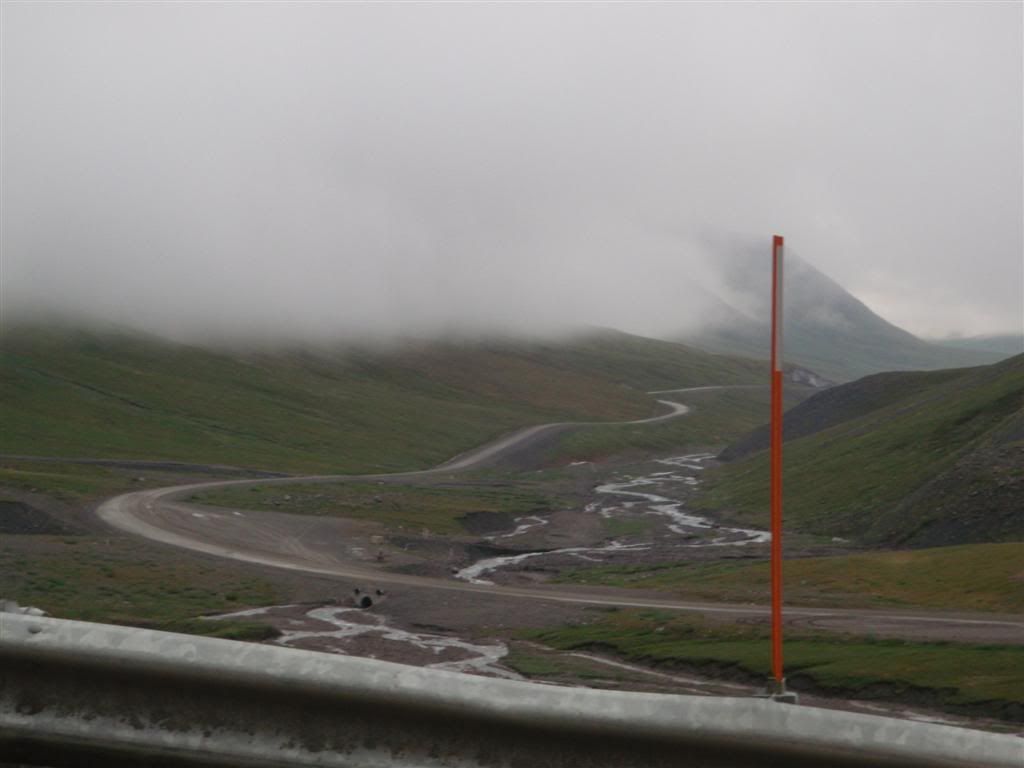
Down we went, out of the clouds.
Almost instantly as soon as you get over the pass, everything starts to change, the trees had mostly vanished a half hour south of the pass, but now things started looking even more desolate. The only things growing were bushes and small trees on the sides of the road and creek bed where the permafrost was deep enough to allow some sort of root system.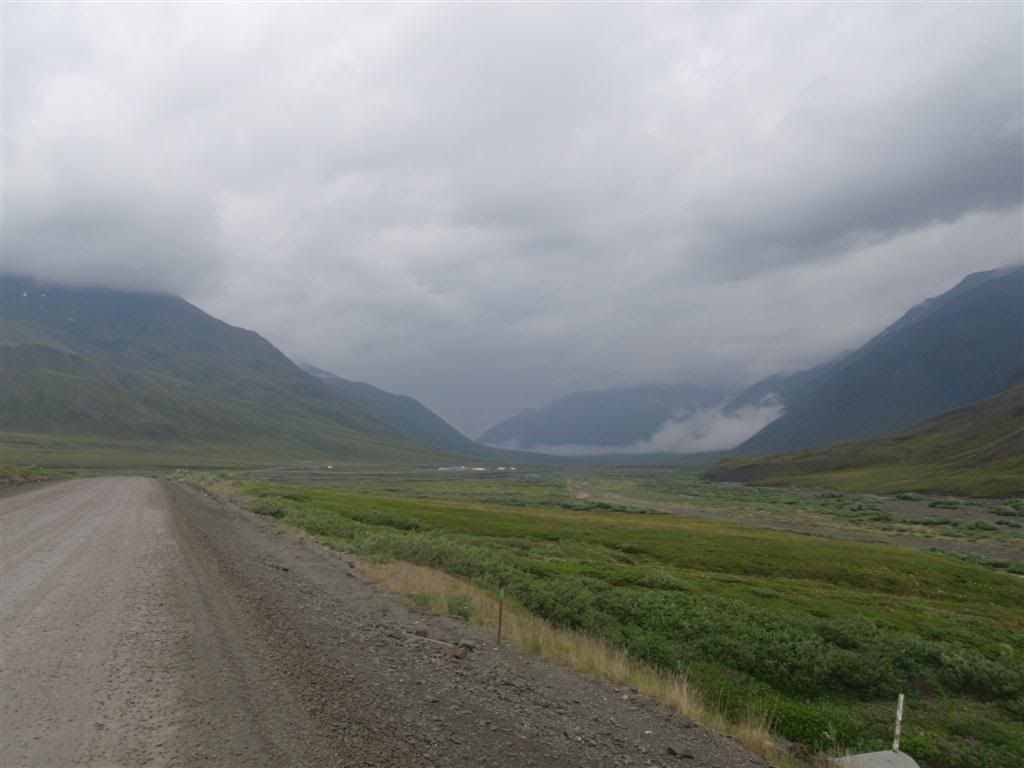
The environment flattened out pretty slowly. The south side was fairly flat until fairly deep into the range, where it did a lot of rapid climbing, but the north side of the range goes down much more slowly, gradually going from valleys to rolling hills.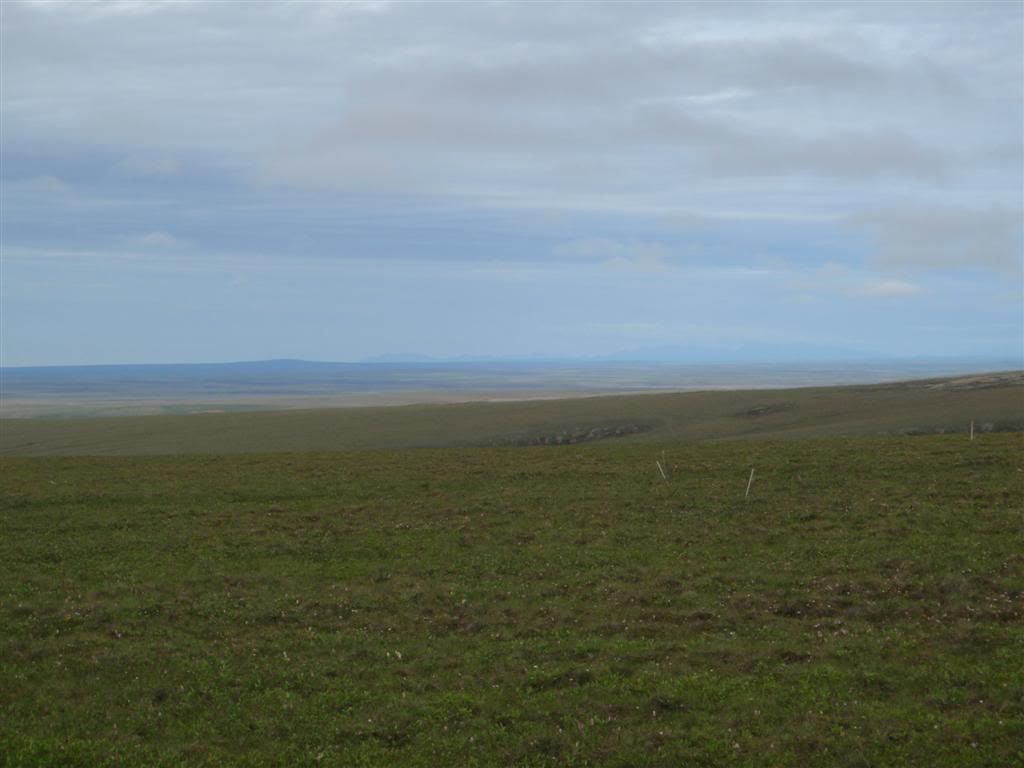
This was just . . . this was the north slope. This was what I was promised, this was what I came here for. The temperatures started dropping, and as I got out of the hills, the wind started picking up. The road conditions started getting worse and worse, as well. 
More softball-sized stones embedded in a hard packed clay. Rough, miserable stuff to ride over. 
Well, that's optimistic.
Riding through this place makes it clear just how tenuous a hold life has here. And this little ribbon of road stretching across this . . . this vast, harsh, barren environment. And this continued for almost 150 miles, getting flatter, colder, and windier the farther north I went.
The strange thing was the little outpost of human touches that you did see. These little roadside pull-offs, hundreds of miles from anywhere, miles from even the nearest pipeline pump station, well-built with information placards about the area. You'd see things like this at any national park in the lower 48, places with lots of tourists, but here? Deep into the arctic tundra? I stopped at every one of them, and learned more about permafrost then I knew existed. Also just how many freaking birds migrate up here during the short summers. Honest to god, there's some that make the trip from Antarctica.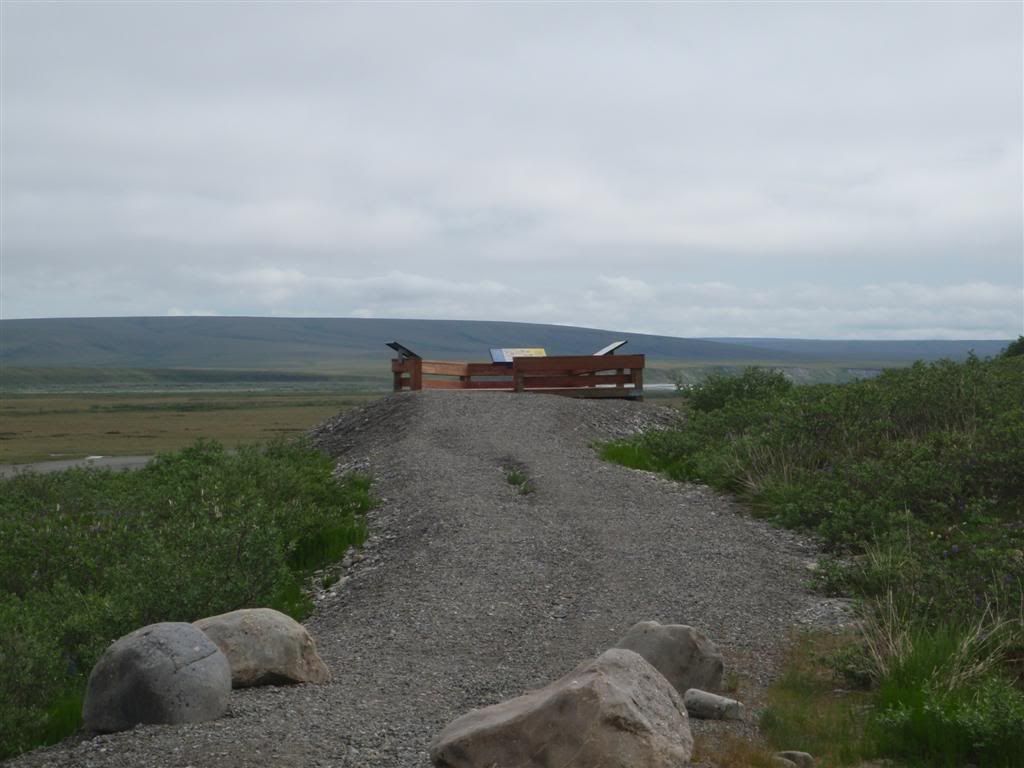
About fifty miles south of Deadhorse, I went by the last major elevation changes for a long while. After these impressive bluffs, it's just endless flat tundra for miles in every direction.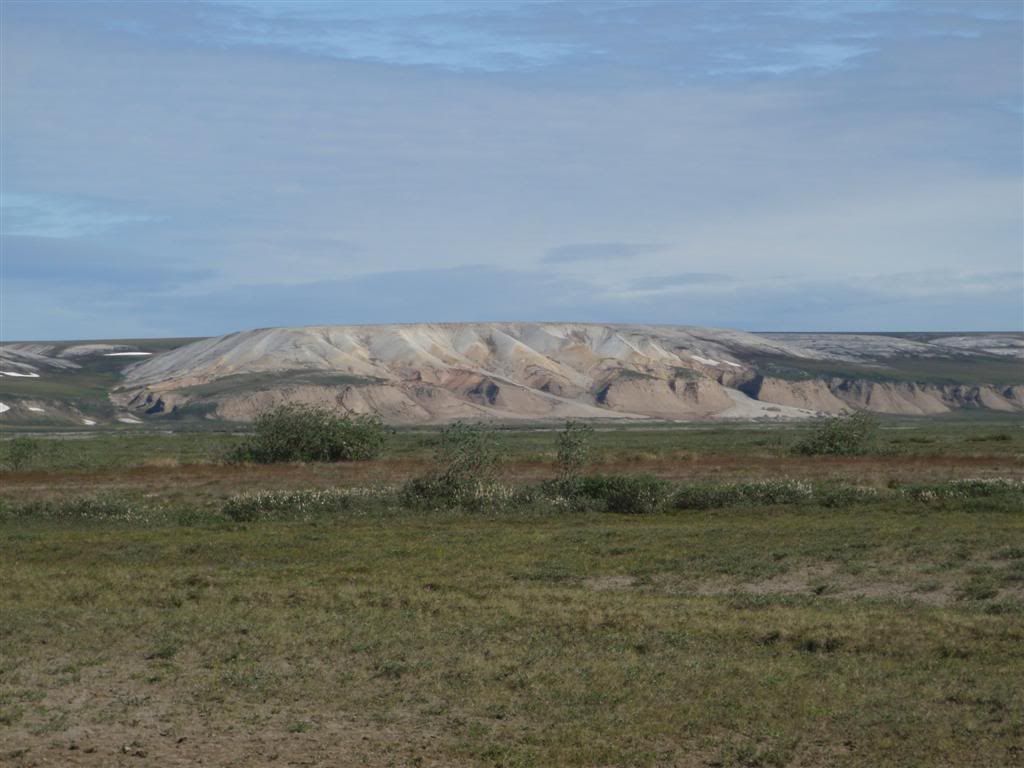

The clouds went away and the sun came out, but that picture is deceptively nice. The temps had dropped to 40 degrees, and the wind was out of the east at almost 35mph. I had my suit liner on, but beneath that was just a tee-shirt, and lacking my winter gloves, I only had my mesh ones on. I was FREAKING COLD, and my fingers were loosing feeling and stiffening up, which isn't what you want on narley gravel roads that can require some fancy clutchwork. I was soon stopping every fifteen minutes to warm my hands up on the engine's cylinders. Fog rolled in just before I got to the town, and the wind died down a little, but I still rode on counting every mile until the end of the road.
I did finally made it to Deadhorse, the end of the road. Deadhorse isn't really a . . . town, per say. It's a work camp. Most people are there on rotating 2x2 weekly schedules (two weeks working, two weeks off back in the real world), or 3x1 for less intense jobs. The really crazy ones are there for up to 8 weeks at a time.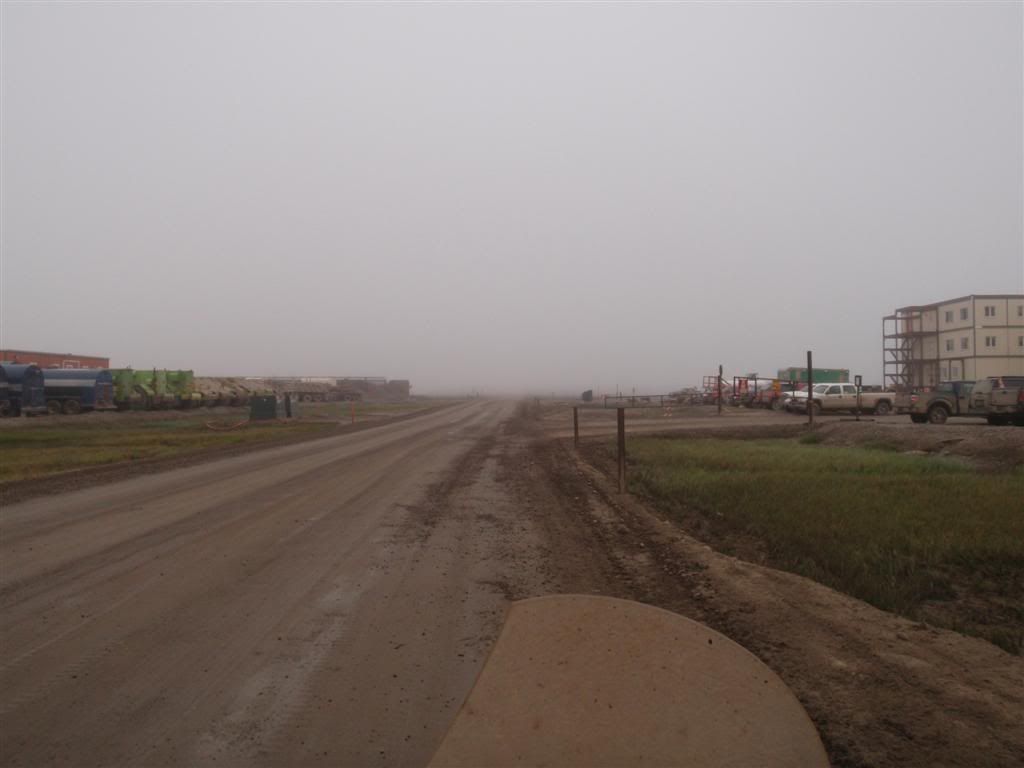
The place was exactly what you'd expect of a work camp in one of the most inhospitable parts of the world. Everything is filthy, covered in the muck that passes for a road surface. It's all prefabbed buildings, things that are obviously designed to break down into parts the size of shipping containers, and there's heavy equipment everywhere. No one, and nothing is there without a purpose; little attention is given to appearances, no one seems to care about aesthetics. Everything is purely functional, people and equipment are there to WORK. There's no kids around (yay!), no one is simply living there because it's where they live. It's a dirty, cold, harsh, bleak and awful place.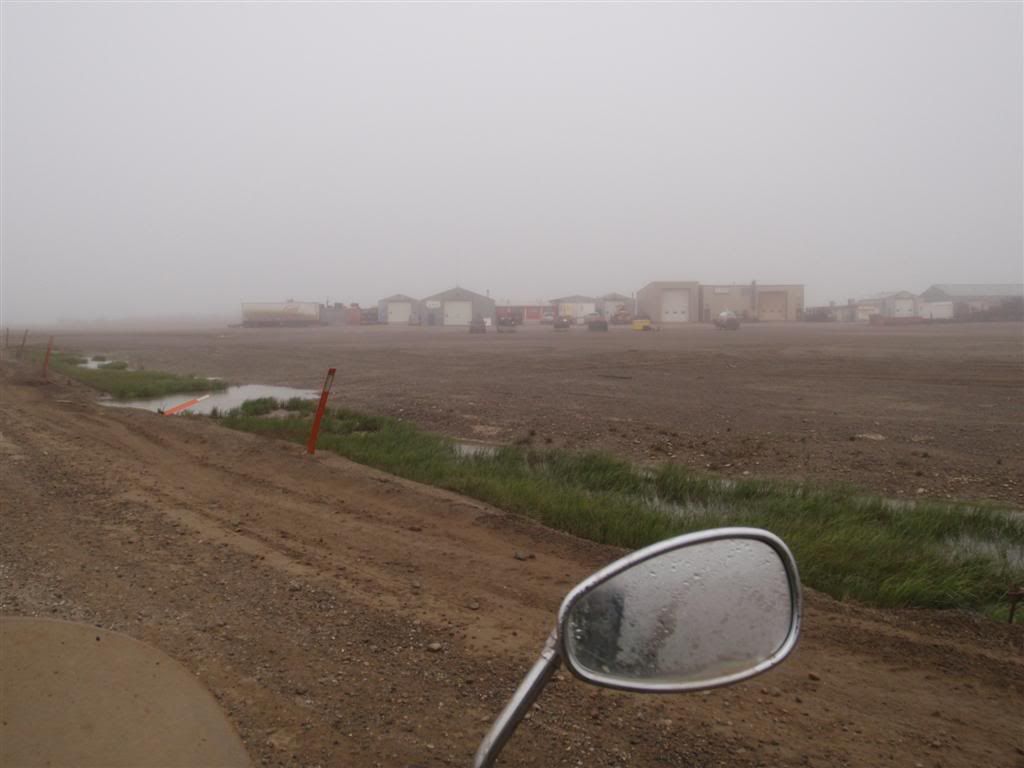
I loved it there. I absolutely loved it. The desolation, the cold, the barrenness . . . I love this setting. This environment.
Right about now, I made up my mind to see about jobs up here. I'm not joking.
However, my stomach had more pressing concerns. I hadn't eaten since a cup of oatmeal 200 miles and 8 hours ago, 8 hours of fighting a bike through lousy road conditions, leaned over in merciless crosswinds, shivering for a good portion of it, and my body was screaming for calories. I resolved that no matter how expensive things were here, I was paying for a meal. Screw my budget, I'm not trying to cook in this weather.
After finding the general store and buying some postcards, I stopped at the first hotel I passed. Telling the hotels apart from the other buildings is actually near impossible; they all look the same. The same prefabbed corrugated paneling bolted together in a two-story box, painted either a muted grey and covered in mud, or painted a bright red, and covered in mud. Only after asking people where a hotel was did I find the place, which I'd ridden past three times.
I stopped in and inquired about their dinner buffet, which I was told was $22. Honestly, that was about what I was expecting. They didn't take plastic though, so I was getting dressed again to go find an ATM, when the hotel manager/front desk guy called out.
"Hey, sir?"
"Yes?" I replied
"I'm sorry, but I just can't charge you for dinner here. It's hamburger night, and I don't think you want to pay twenty-two bucks for a burger and fries, and I don't want to charge you that. Head over to the Prudhoe Bay Hotel, over by the airport. Their buffet is twenty bucks, and they're having sirloin steaks tonight."
I was minorly shocked that he was telling me this. "Really? Well . . . goddamn, thanks for letting me know that."
"Yeah, and they take credit cards there too. I'm sorry man, but I just can't charge you twenty-two dollars for a burger after what it looks like you've been through" (I guess he'd taken a glance at my mud-covered riding suit). "Go over there, get yourself a steak. Their salad bar is a lot better then ours too."
I thanked the guy profusely, and followed his directions over to the Prudhoe Bay Hotel, which I probably never would have found if he hadn't told me exactly where it was. All the roads look the same, all the buildings look the same, but I did find it.
Heading in, it appears the other hotel manager was right. This place was a heck of a lot nicer feeling.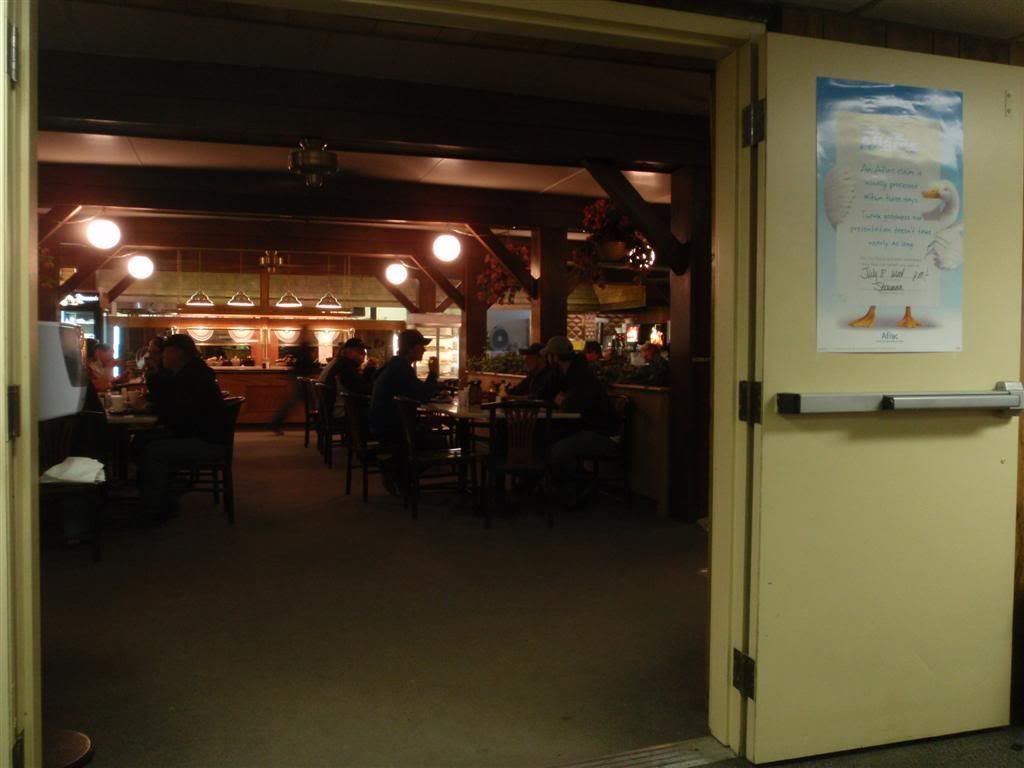
They even made a good attempt to make the dining room feel homey, with luscious fake plants and fake wood paneling. After the miserableness outside, this was heavenly. True to the other guys word, it was indeed steak night. All you can eat, which again, I took as a challenge.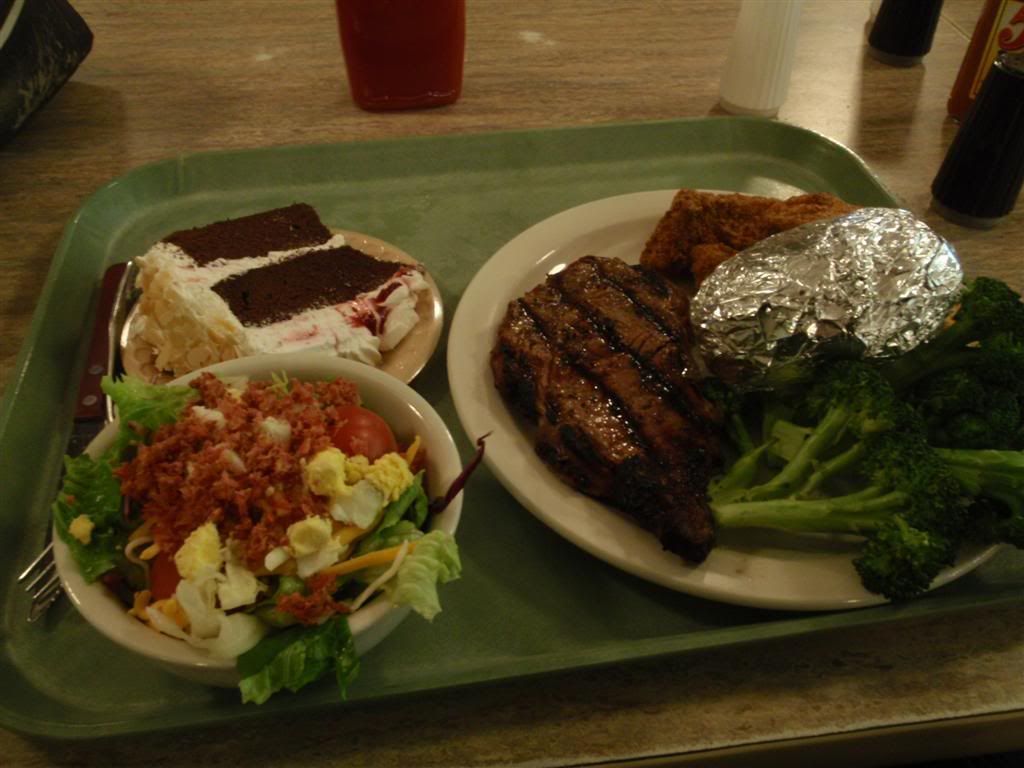
Really, $20 for a huge steak dinner with drinks and dessert isn't a bad deal by any standards. A damn good steak, fried cod, baked potato, fresh steamed broccoli, a "salad", cake, and (not pictured) jello and custard. Fuck. Yeah.
I stayed there for a couple hours. Oddly, I HAD A FREAKING CELL SIGNAL HERE. How the hell? I sent a couple text messages, and tried to make more phone calls, but my phone was acting up on me and kept shutting off. Eventually I had enough, and headed out.
By this time it was almost midnight . . . which didn't really matter. But I did hear scuttlebutt that the weather to the south had taken a lousy turn, and there was rain in the Brooks Range. Greeeeeat. But it wasn't like I had a choice. I put on some extra layers of clothes under the suit, put on my slightly warmer work gloves and glove liners, and headed, going back south. I was as far north as I could possibly go, so there was no place to go but down.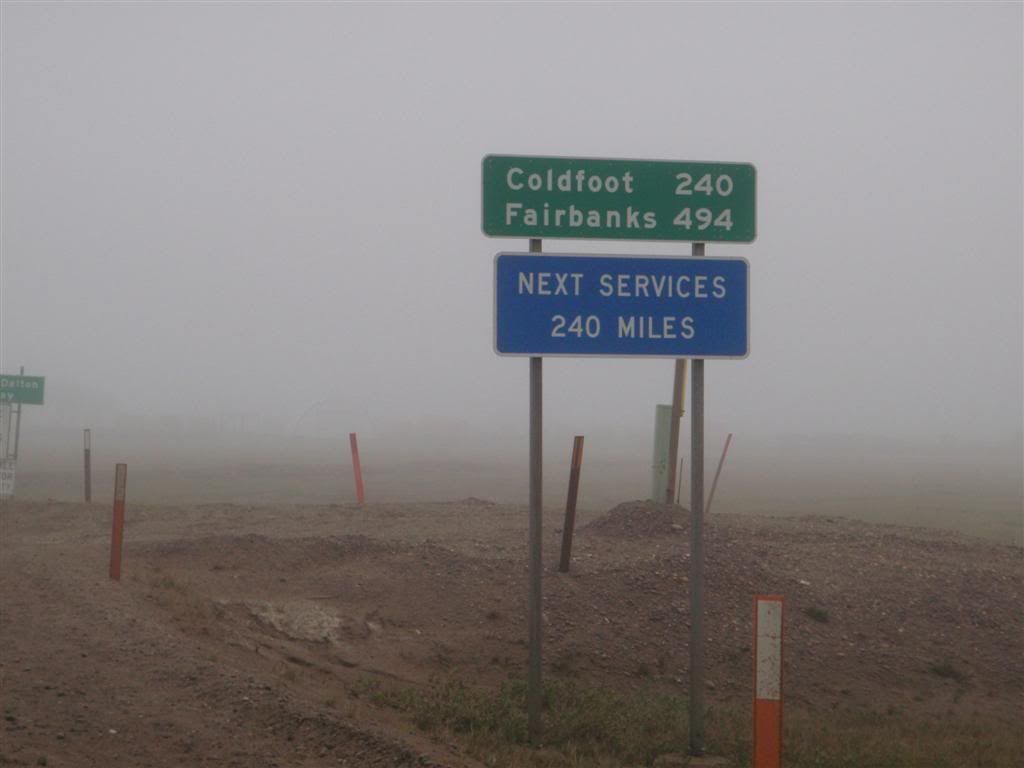
I had a long, long way to go. The bike was on the reserve and the spare tanks were empty, so I found the only gas station in town to fill up.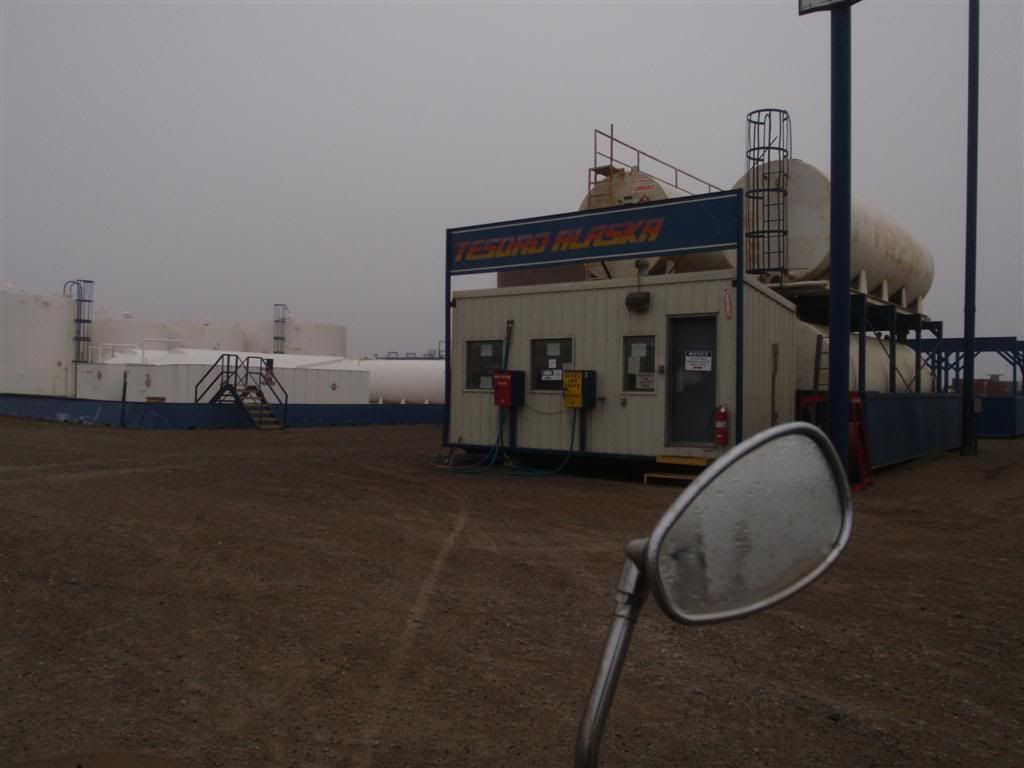
The gas pumps are kept indoors, on the other side of those two windows, and the station isn't manned. You go in that door, swipe your card in the machine, and punch in the pump and fuel type you need, then go outside to pump the gas. A NO POINT in the whole process does it tell you how much you're paying for your fuel, because . . . well, what choice do you have? You're in the middle of fucking nowhere. Not just regular nowhere. FUCKING nowhere.
After topping off the main tank, and the red spares, I headed out of town. I had a long way to go before I was anywhere at all.
Life prevails anywhere it can. Even in these obscene conditions, things grow, survive, and thrive.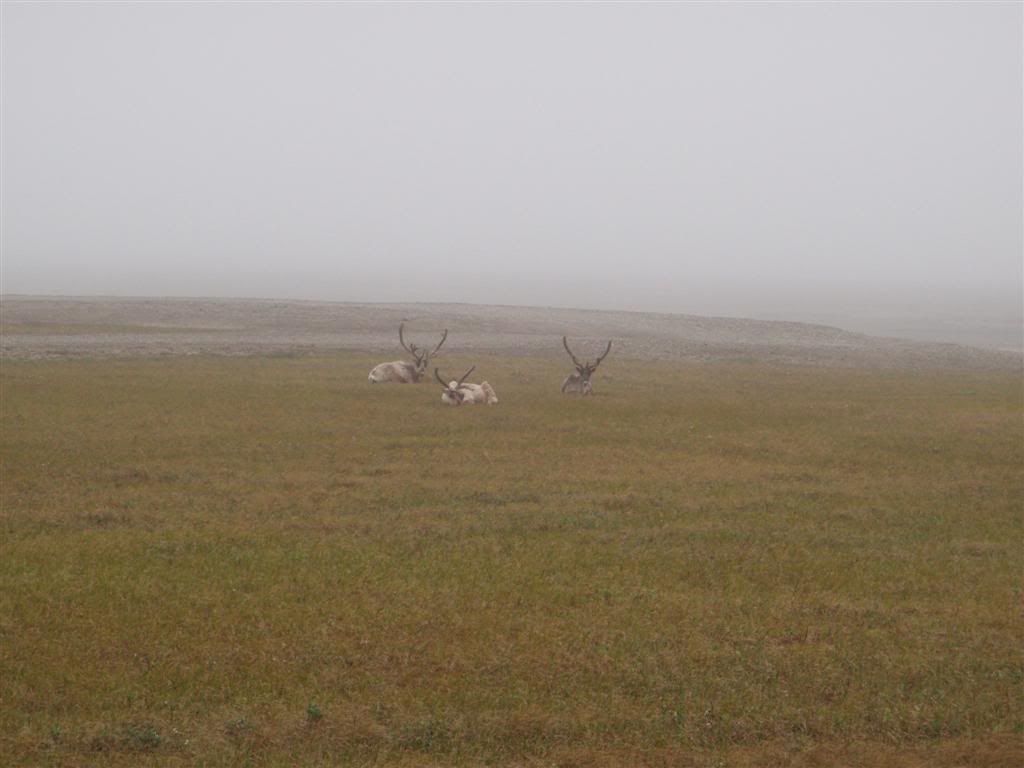
Those same bluffs that were sun-drenched on the way in were now trapping the clouds. 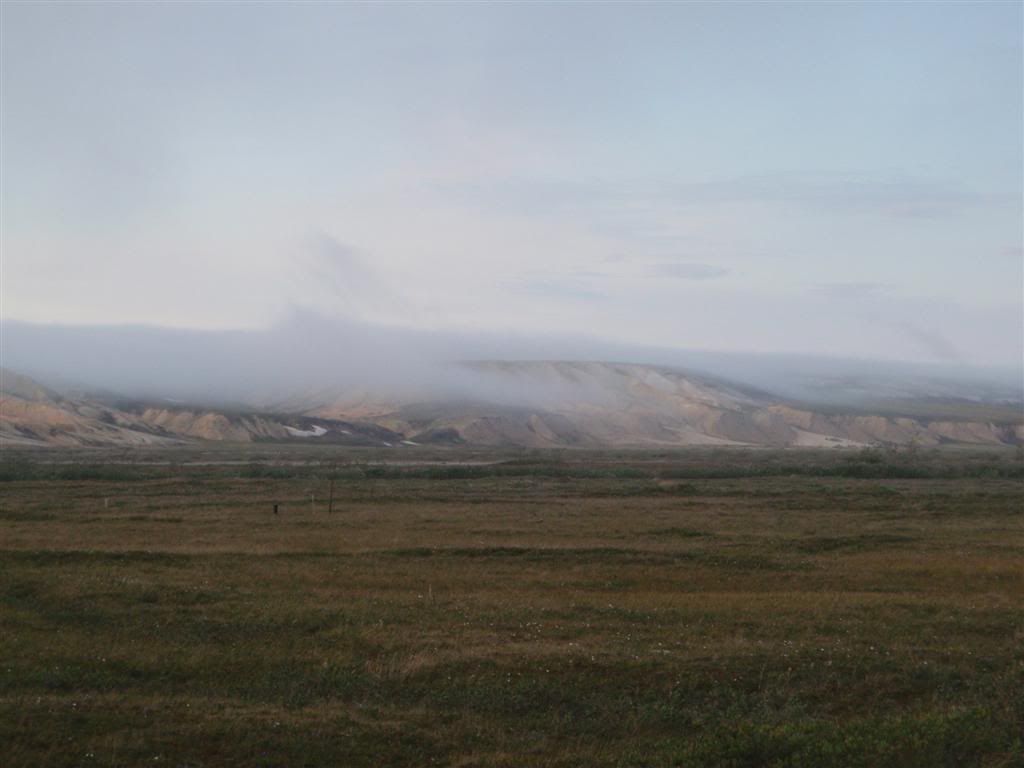
This was my view for the next 50 miles heading south from Deadhorse. I can't describe just how small this place makes you feel.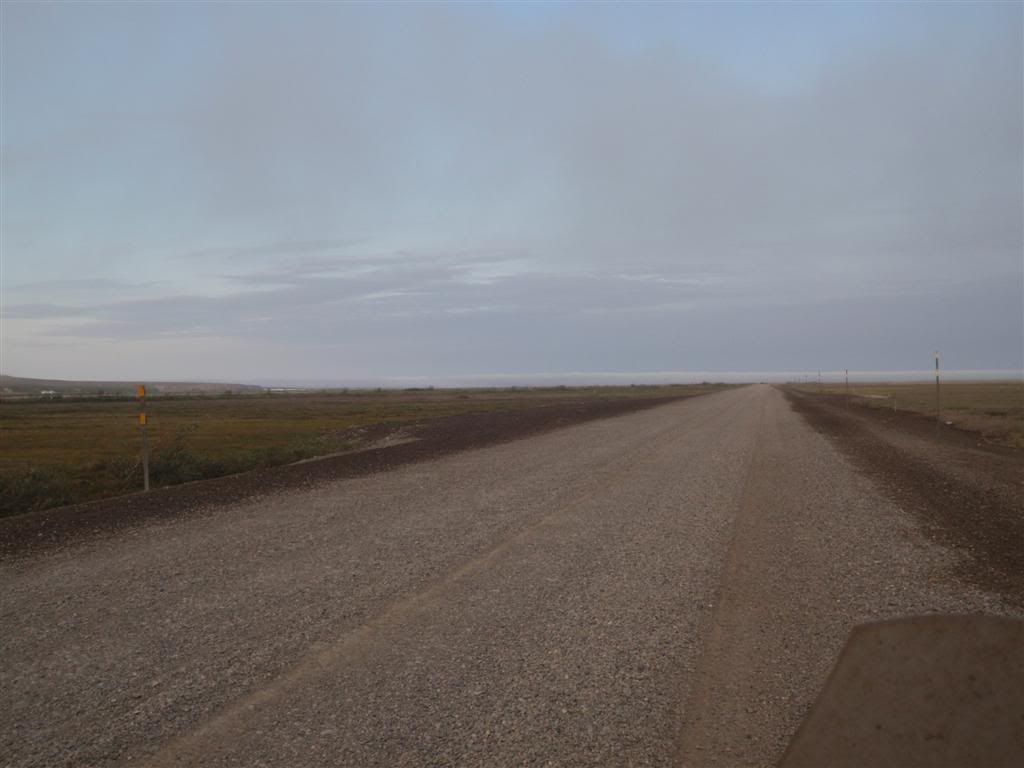
The sun was due north, which the more you think about it, is something you'll never see in any other part of the world. I ran away from the fog for a while, and during a clear bit, I turned around to look at Sol.
Taken at almost 1:30am.
Now, this road . . . the road conditions varied all the way up. But undoubtedly, the worse section is the last 50 miles south of Deadhorse.
I can't describe accurately just how bad this road is to ride on. It might not look that bad in this picture, but that's more of those half-buried rocks that are rougher, much rougher, then riding on a cobblestone street. But worse was that they'd fairly recently dumped a load of fresh gravel on it. So you had the tire tracks left by the big trucks, which were rocky, rough, and washboarded to all hell, but then in between the tire tracks, you had a six-inch-deep mount of fresh, loose gravel.
There was no good option here. The gravel was so loose that the front wheel was little more then a rudder, but the wheel tracks felt like the bike was going to be shaken apart, even at 10mph. Sometimes you'd see the washboarding coming, but often you wouldn't, and it feels like someone pounding on the bottom of the bike with a sledgehammer. Even if you DID see it coming, there was often jack squat you could do about it besides hit the brakes and slow down as quickly as you dared without locking the wheels. The gravel patches were way too loose and far too deep to make switching over to a hopefully smoother wheel track an option. It took me almost four hours to make it 56 miles; I left Deadhorse at midnight, and didn't camp until I hit a small section of paved road at 3:55am.
There's a seemingly random 30-ish mile of good, smooth pavement in from 56-ish miles south of Deadhorse down to one of the pump stations. I'm told that it's a test section, they paved it a year or so ago just to see how paving would actually hold up to these conditions over the years. If it does hold up, or turn out to be roughly the same cost to fill the potholes as it does to have the graders keep going over the dirt and gravel, there's a chance they'll pave more. Which I have mixed feelings about, to be honest.
The fog that I hoped I'd left in Deadhorse had caught up with me, making my rear-view mirrors useless, fogging up the vision, and then the glasses. Even on this babies-ass smooth road, I was still puttering at 30mph, because that was the best I could do with the wind in my eyes. I had to keep the visor up and push the glasses down so I could see anything at all.
At some parts, the good asphalt did give way to small gravel sections, which I couldn't see coming until I was almost on top of them. The fog was that thick.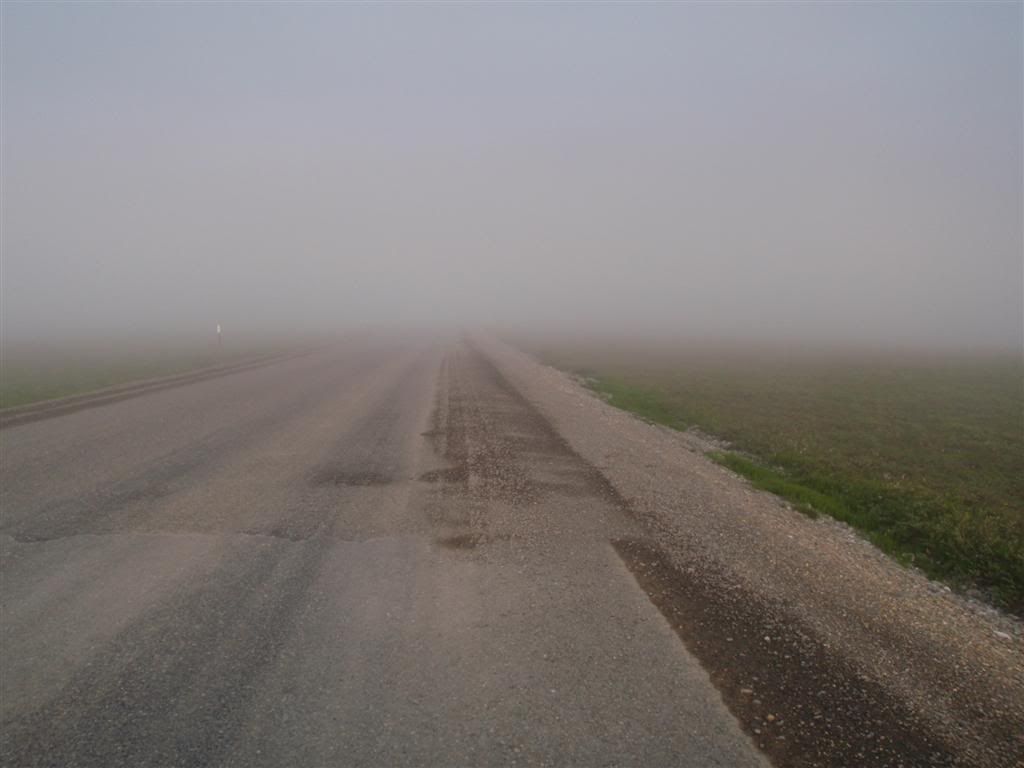
I did get out of the fog after too long, though. As I started getting into the foothills of the mountains, I climbed up out of it, into the colder, but less humid air.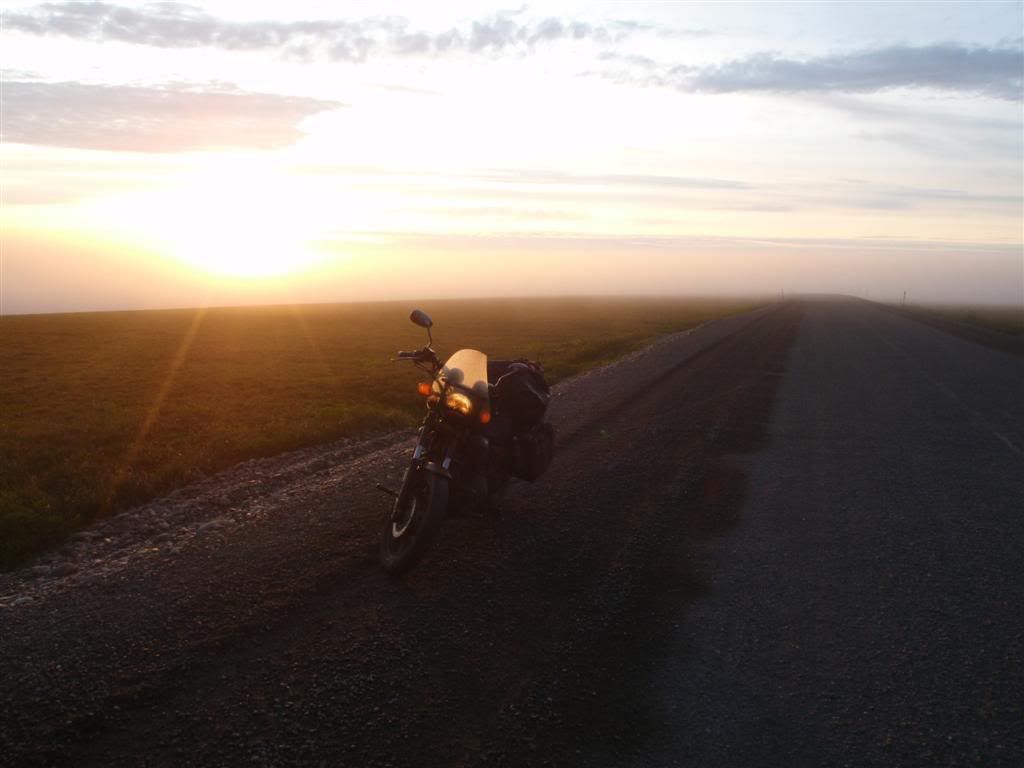
I could see the fog settling in the valleys around me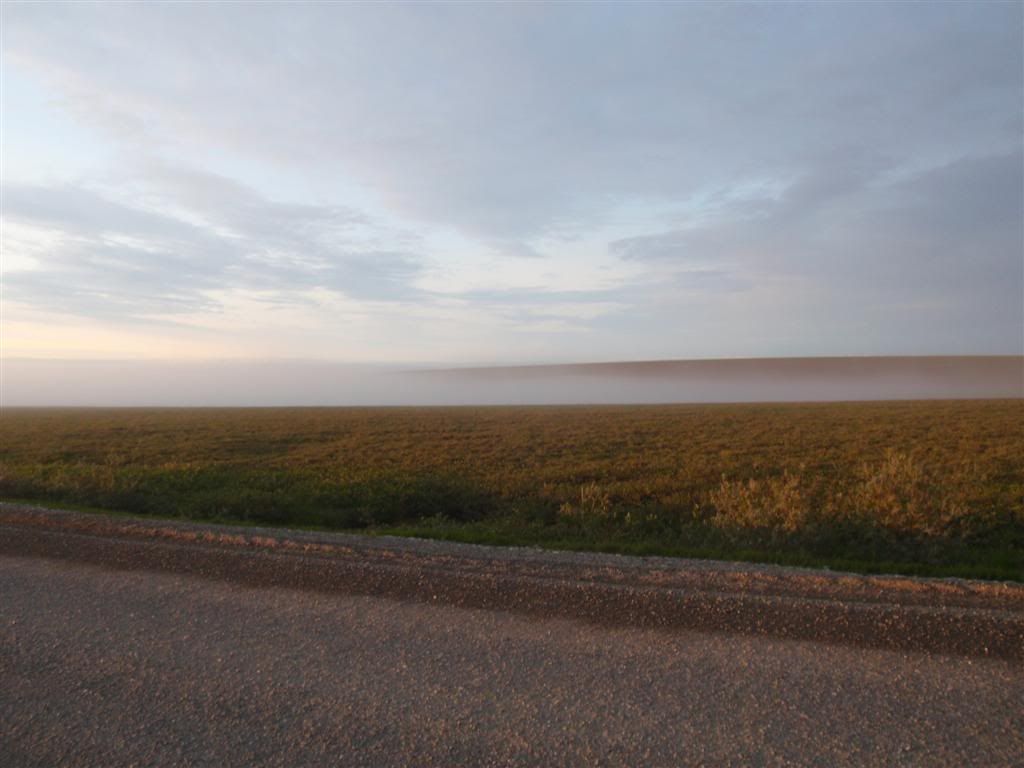
And the road continued on.
Stopping to take pictures gave me a chance to get the first really good look at my bike. It was . . . it had a little dirt on it.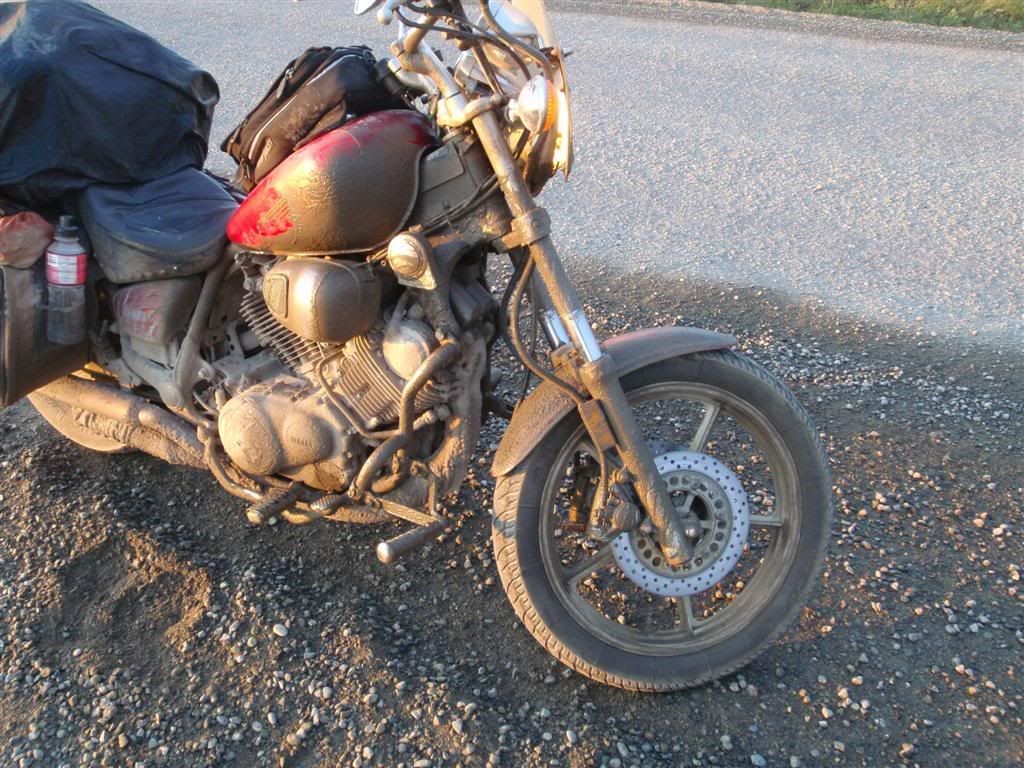
You'd never believe that there's chrome under there, huh. I hadn't escaped the mud, either.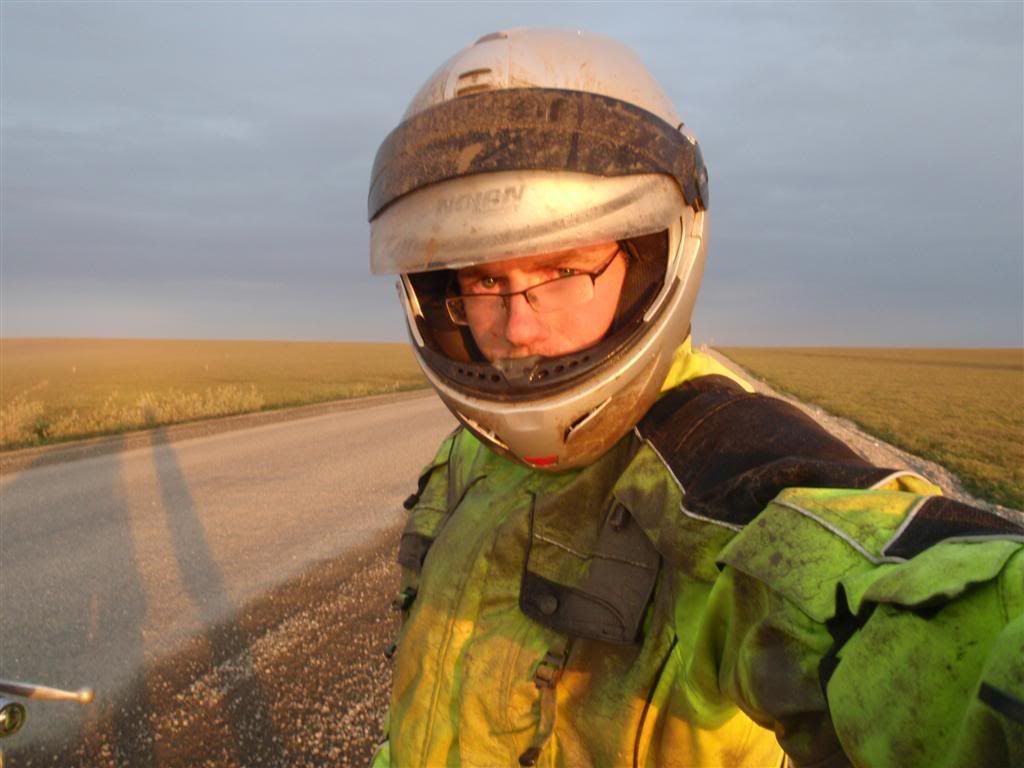
The visor was almost useless for all the schmutz on it.
Right about now, the weariness really set in; I was so tired from fighting the washboarding for the last four hours that I had to camp, and soon. I headed over to the river, down this . . . wasn't even a road. More a trail of huge, incredibly loose stones. 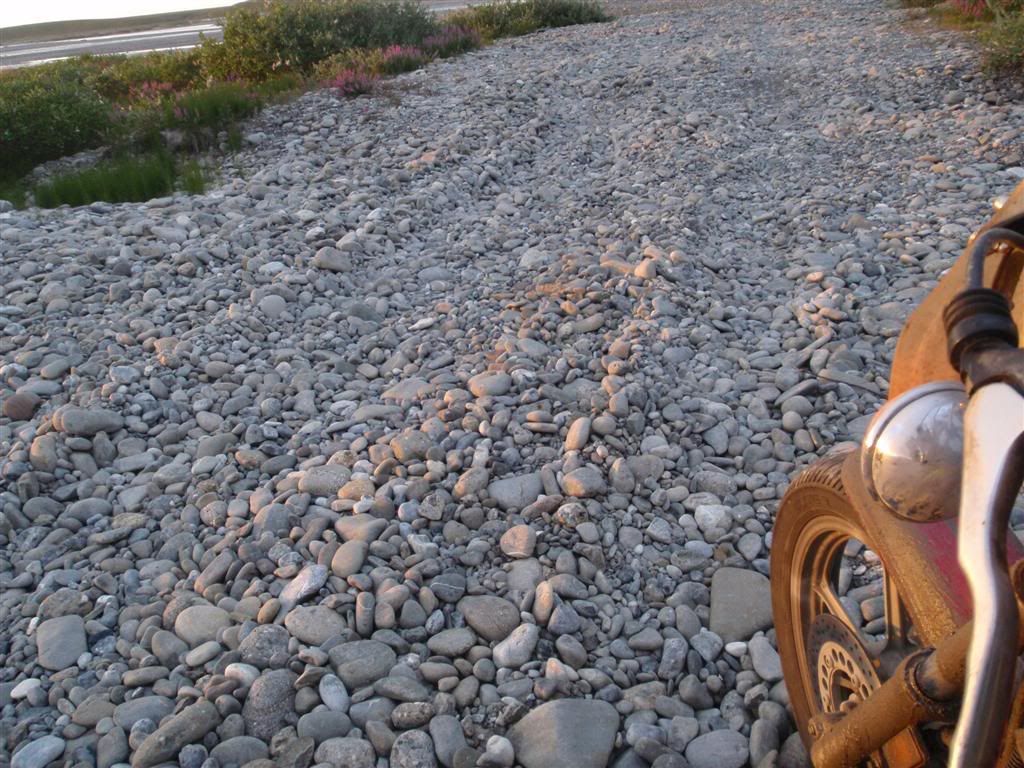
I hadn't found any rain so far, and while I really wanted to take advantage of the dry conditions for as long as I could, I was simply too tired. I found a flat spot of gravel, put up the tent, and went to sleep at 4:30am. In full sunlight.
I awoke the next morning at around 9 am to a rainstorm, wind, and general miserableness. It was so cold, and raining so hard that just the idea of going outside for a morning pee made me shiver, so I sacrificed one of my many plastic grocery bags as a piddle pack. I tied it off and tossed it out of the tent as far as I could, resolving to pour it out and pack the bag away when I did leave. I have no interest in leaving trash all over the north slope. With an empty bladder, a warm sleeping bag, and a rainstorm outside . . . I went back to sleep.
That evening, hunger struck, and while making dinner, I recorded myself talking some more. I should mention that when I say 8:30 in this video, it's PM.
The rain did let up, and looked like it would stay away for a while. The skies were gray, but not too threatening, and the humidity dropped enough that the ground began to dry some. Around 10pm, I got out of the tent for a wander.
The rain had left the ground saturated, so much so that the bike's kickstand had sunk down to a precarious level. 
I found a large flat rock to shove under it before heading out for a walk to the river.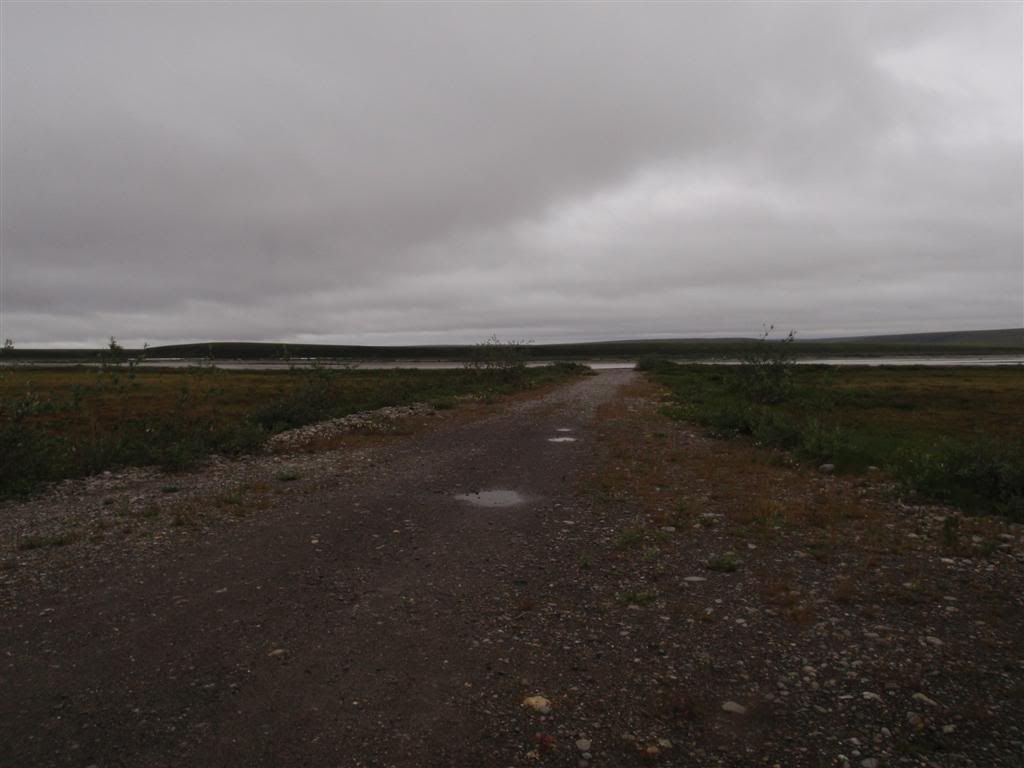
This place was . . . so alone. It was cool, maybe 50 degrees, breezy enough to keep the bugs (sort of) at bay, and just . . . quiet. Very, very quiet. Very rarely, a truck would pass by on the highways, but it was getting to be "night time", so the traffic was pretty minimal. It was just . . . there were times where I was seriously the only person alive for miles in any direction. Not only was I alone, but I was alone in one of the most remote places you can reasonably ride too. This place where life has such a tenacious yet fragile grip, where winter is 9 months of the year and regularly hits -60f. Except for the road, there was no trace that humanity even existed. And I was alone in this place. I can't describe what it was like. It was perfect. 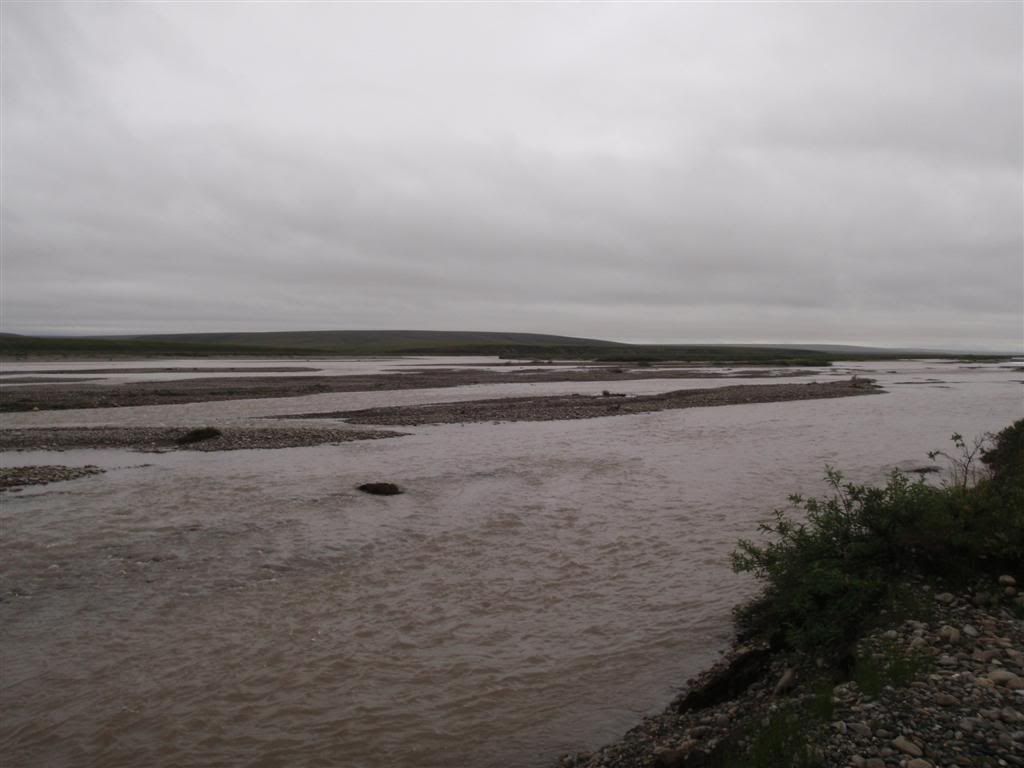
I walked for almost three hours, wandering up and down the river, skipping stones and enjoying cold and damp. The only noise was the river, and the unrelenting wind. Everything was grey, or a muted green and brown. Eventually I got far enough away that I lost sight of my tent, and the road, and everything that might identify this place on a map. I could have been anywhere on the north slope. I could have died right then, right there, and my body would probably never have been found, consumed by the enviroment. Far from my tent, my bike, and the thin asphalt link to the human world was . . . so perfect. I could have spent a week camping up here and been perfectly happy alone the whole time. I really wish I'd had more time up there to simply . . . be. 
I have a feeling this isn't going to be my only trip to the North Slope.
Even though I didn't quite want to, I low on food and clean clothes. I packed the tent up around 1am and prepared to deal with whatever lay to the south.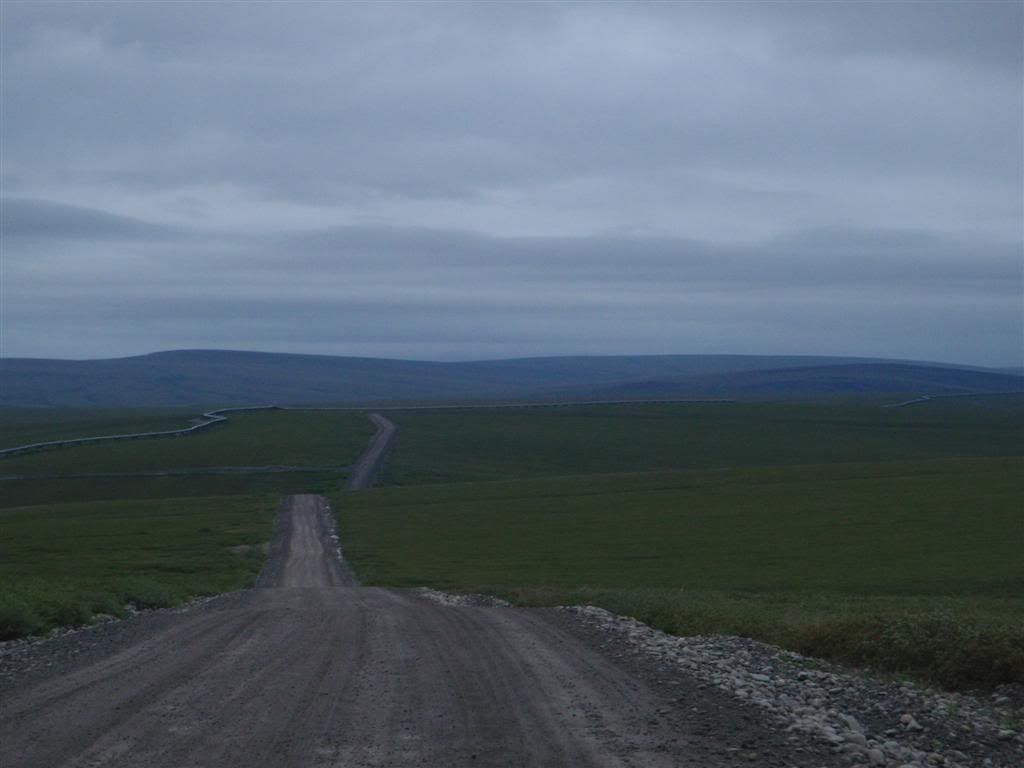
The clouds got thick, seeming to be always on the verge of raining. It started getting dark, even though the sun was still well above the horizon.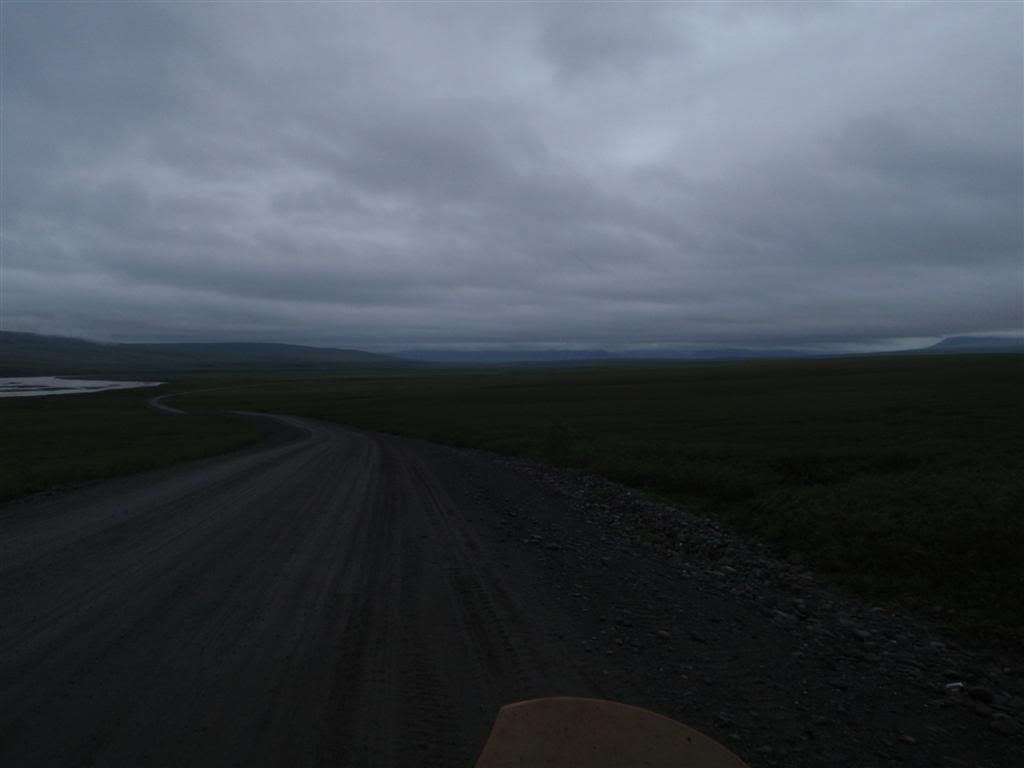
The asphalt soon ran out, giving way again to dirt and gravel. The rain had taken it's toll, softening the road up to allow it to get fulled beaten to hell by trucks. I spent the majority of the time in first and second gear, puttering between the potholes, loose gravel, and muck patches at 5 or 10mph.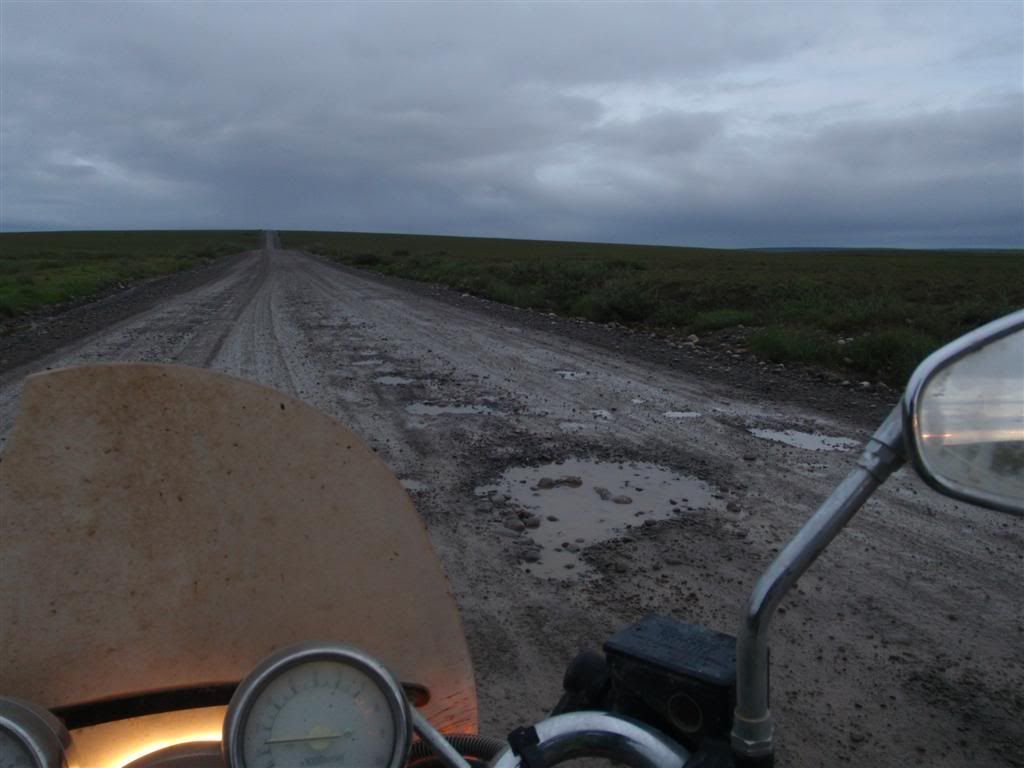

This was some nasty, nasty stuff. Most of the time I could pick a decent route through the mess, but sometimes there wasn't much option besides goosing the throttle to lighten the front end, and hoping the sludge wasn't too deep. 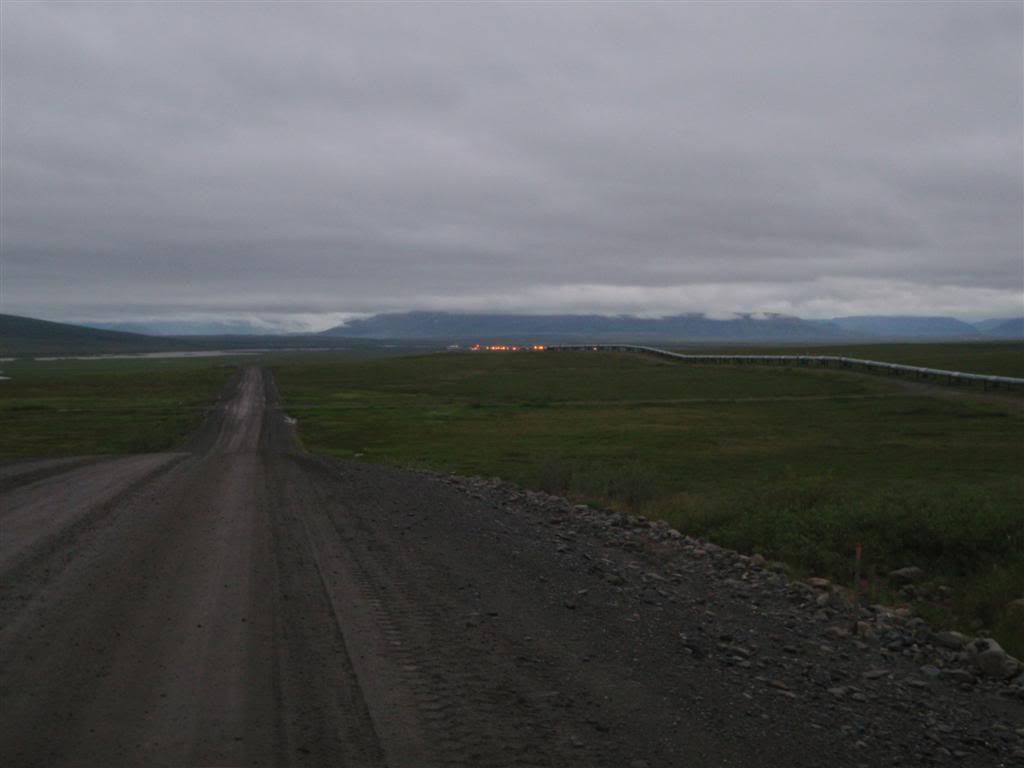
The lights of the pump stations off in the distance. They stand out so hard against the landscape.
The north side of Brooks Range climbs much more slowly then the south, but gradually I was getting closer and closer to the clouds. Sometimes I felt like I could reach up and touch them.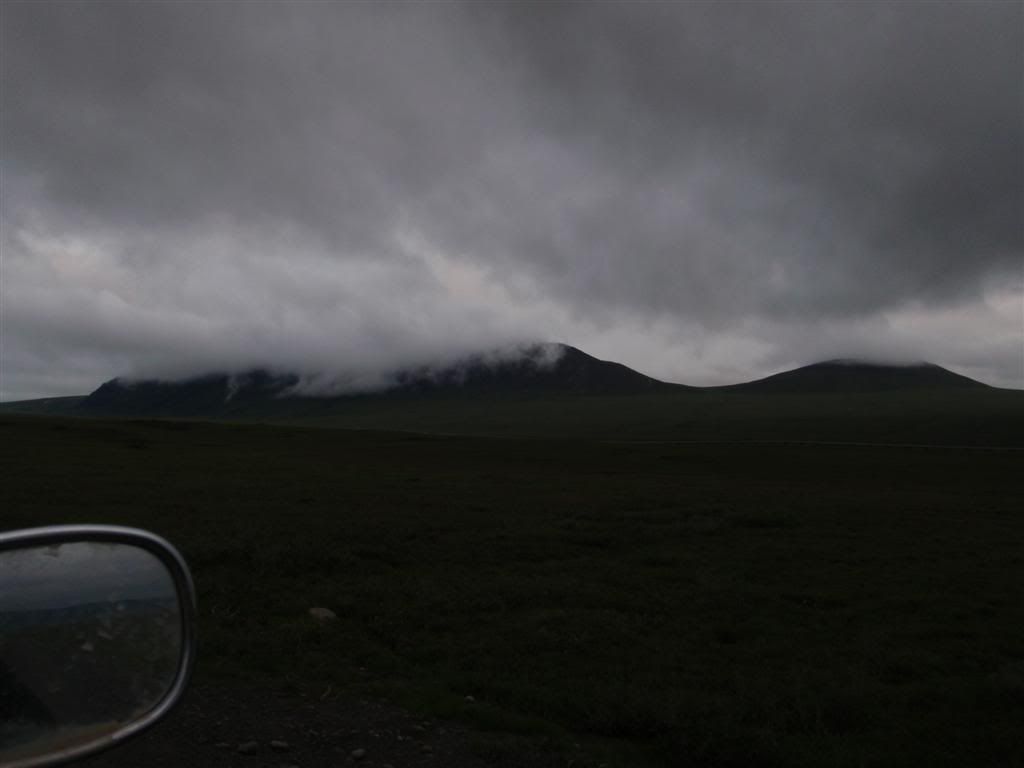
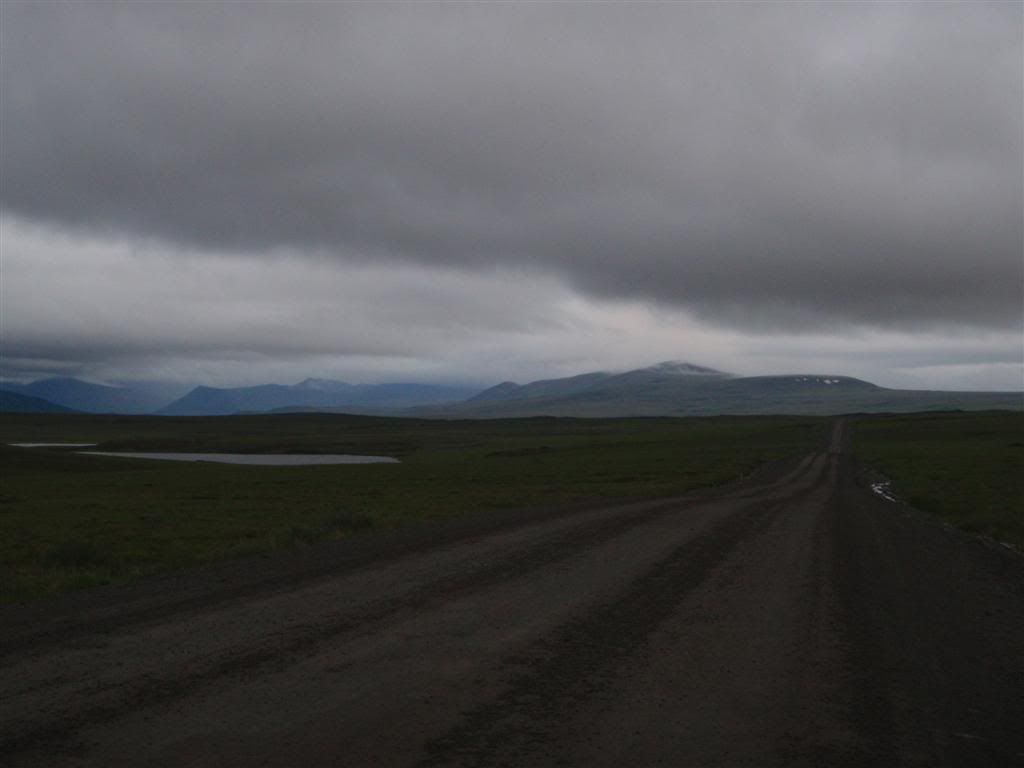
I hit the reserve tank about 30 miles south of the mountains. I stopped at a turn-off on top of a ridge where there was enough breeze to lessen the bug swarm and re-fueled behind some sleeping trucks. The mud here covers EVERYTHING.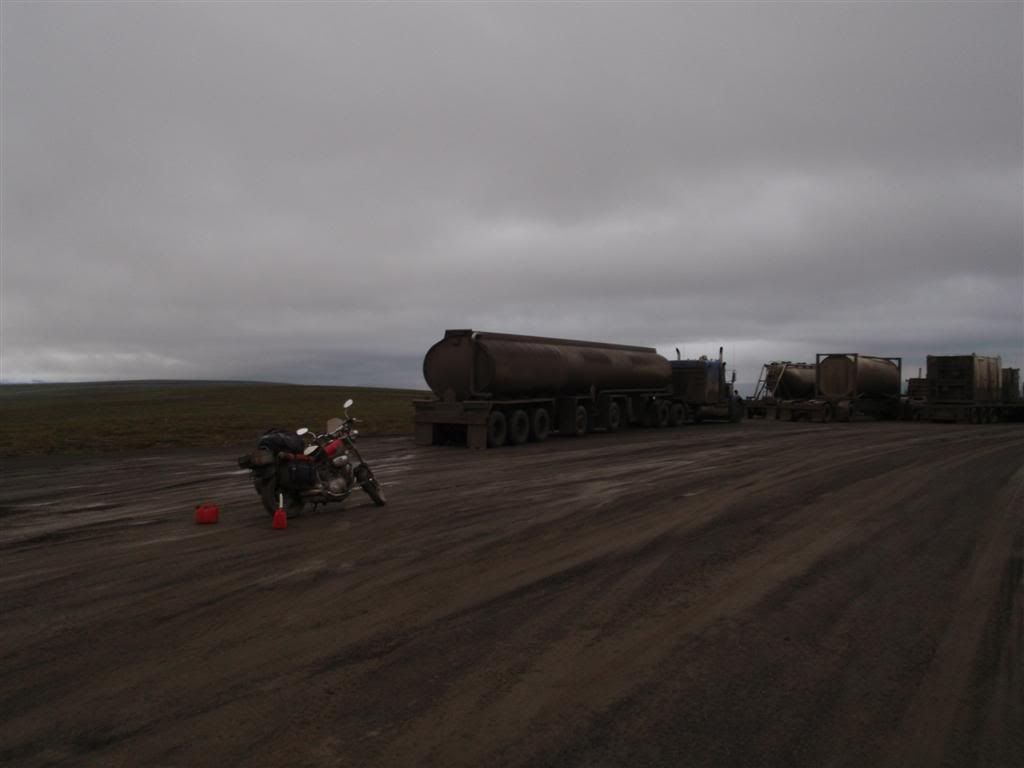
Refilling here was just . . . it was one of those moments I'll never forget. Using my leatherman to untie the knots holding the tanks on because my fingers were too numb and stiff to work properly, swatting away the bugs and shivering at the same time, and trying to keep the bike from falling over on this amazingly slippery mud. Feeding this machine that was my only possible link to the world, it's guts a cacouphony of precicsely mated metal parts moving with such incredible speed and cleanlieness, yet coated on the outside with an impenetrable layer of mud and filth. I was as careful as I could to not get any dirt into the gas tank; ripping off the carbs and dropping the float bowls to clean out a clogged jet was not something I wanted to do here. I was depending compleatly on this machine for everything in this enviroment. My life was in it's hot, steel heart.
I love my bike.
. . . okay, that's enough being emo for now. I road on.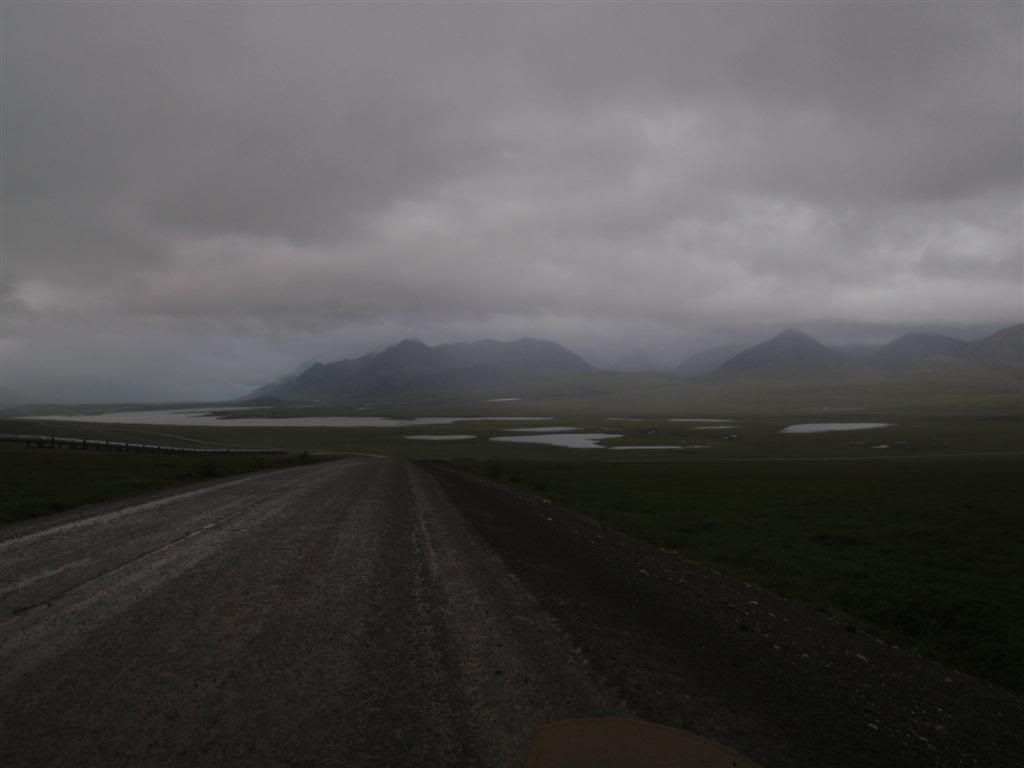
What was that off in the distance? Rain. It was unavoidable, I suppose. It wasn't too bad, though, it served to help clear off the visor a bit, and was patchy and not too heavy. By the time I got to the pass, it had stopped raining, but now I was back up into the clouds.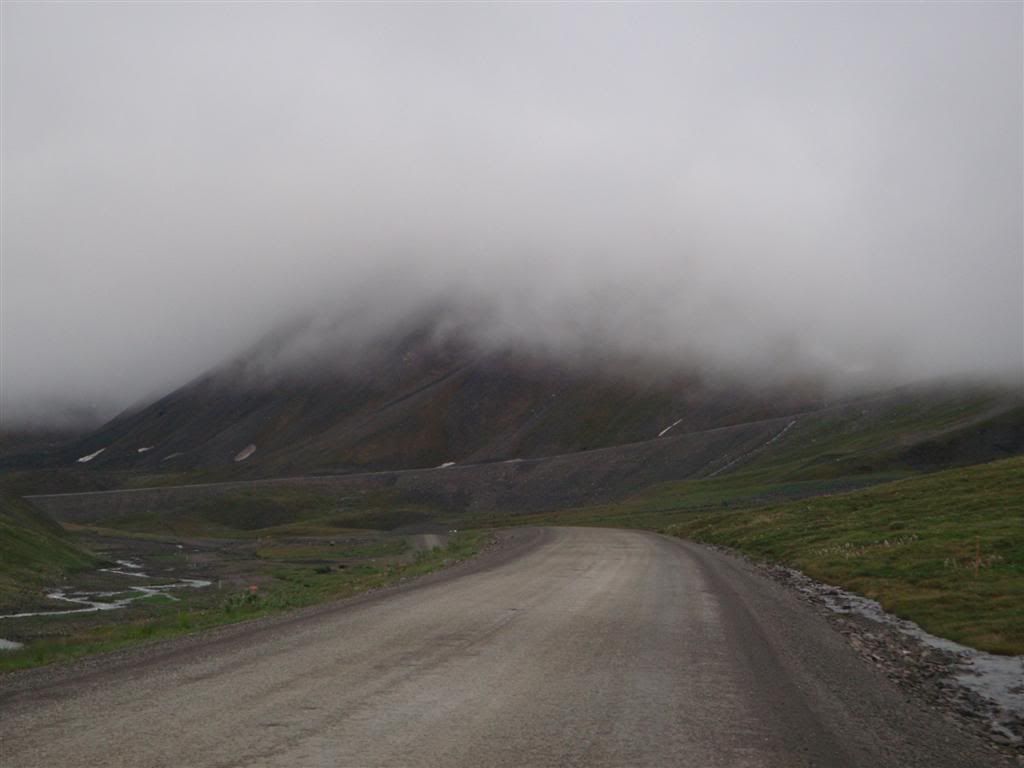
This road is a hell of a lot steeper then you'd think, at parts approching a 15% grade. It's never dry up here, and trucks hauling heavy loads struggle for traction, turning the road into pure slush.
I can't describe how scary this part was, how slick this mud is. Experience on the Liard and the MacKenzie highways in the Northwest Territories gave me some clue on how to deal with this, but there was hardly any part of the road that was rideable at all. The ONLY section that seemed to give any real traction was this solid-ish bit on the extreme left side of the road.
Which left me with a hard choice. I ride on the left, where I have more traction and control, but risk getting mushed by a truck barreling downhill out of the fog, which I'd never see coming. Or ride in the mush on the right side.
I chose the right side. Which turned out to be a good choice, as about thirty seconds after I took this photo, a 24-wheeler slid by out of the fog, the trailer wheel's ABS systems kicking on and off, shuddering the whole rigs in a search for precious traction. The rig looked to be in control, but not by much. There's evidence of a good number of wrecks here.

This road was simply a mess. What the hell was I doing in this place, on this bike.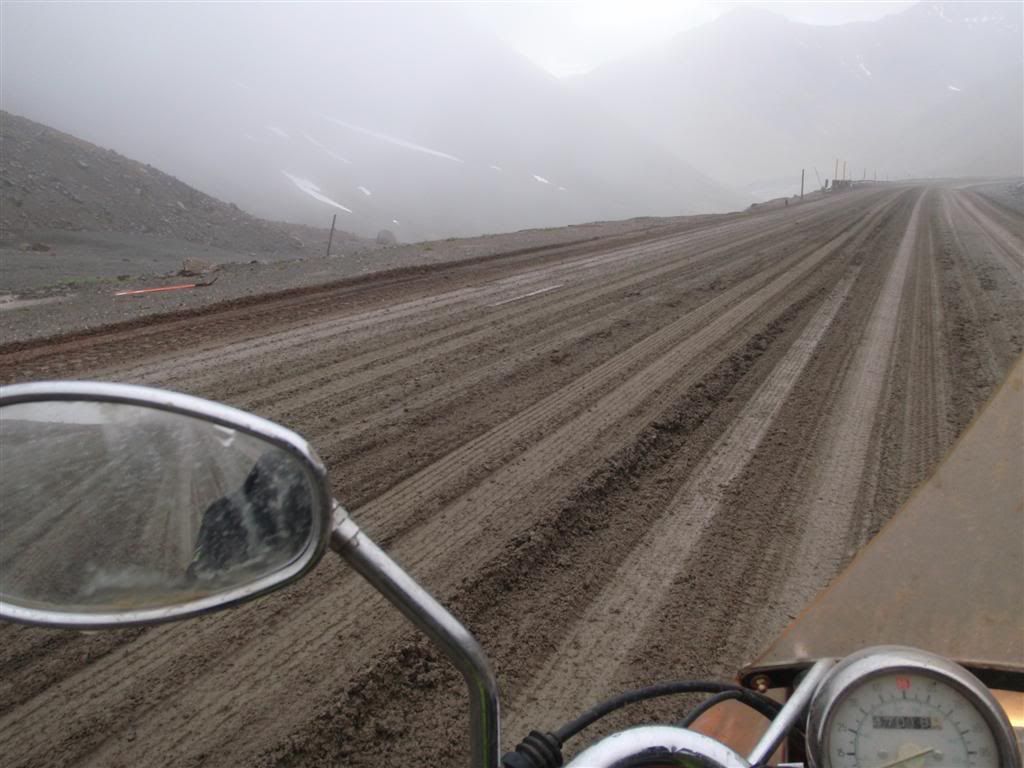
Just as I crested the pass . . . wait, what's that off in the distance there?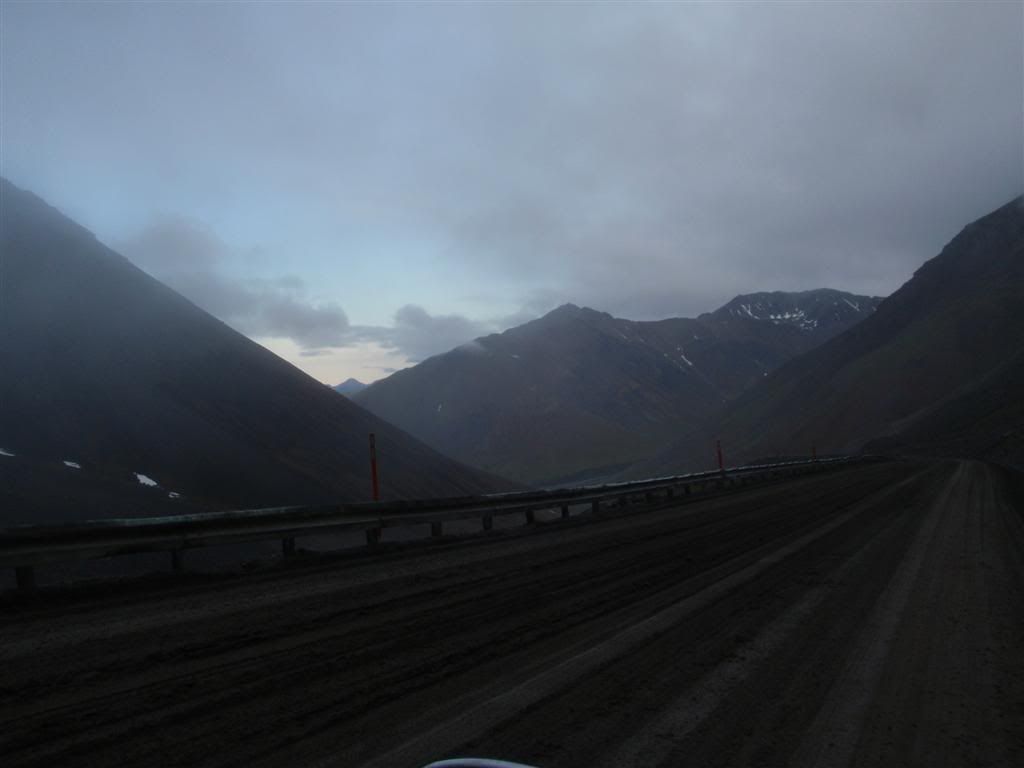
Is that clear, blue sky!?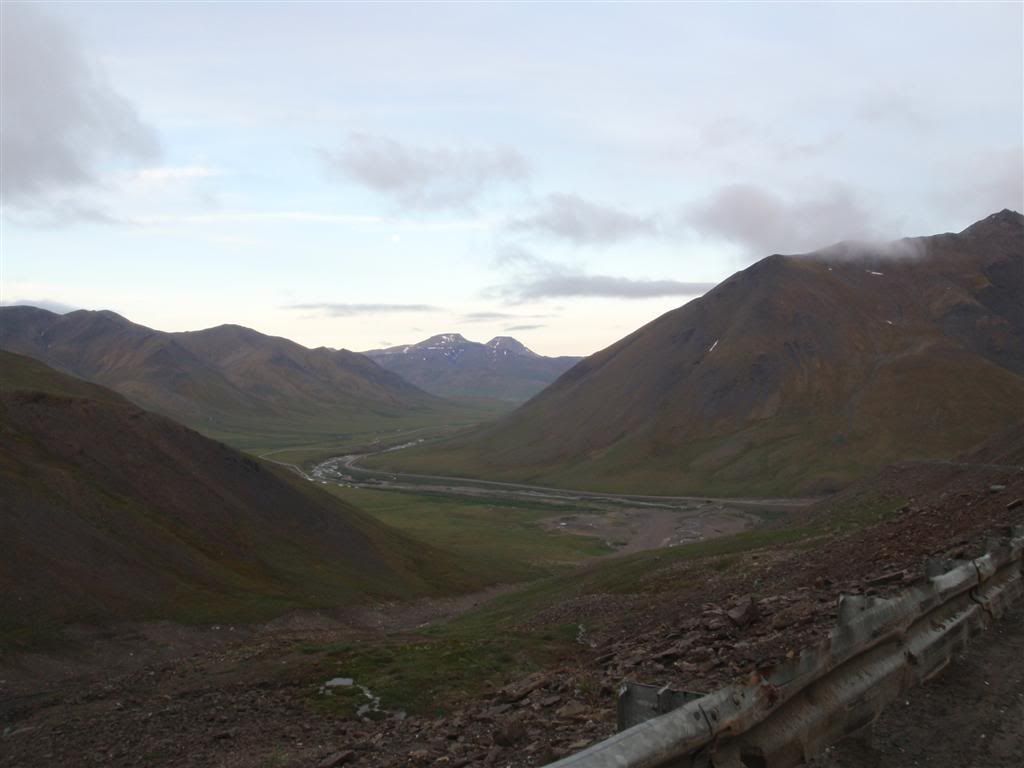
IT WAS!
The change as soon as you get to the south side of the pass really is dramatic. There were a couple more foggy bits to get through, but it quickly cleared and I dropped rapidly out of the clouds, loosing almost 3,000 feet of alititude in (what felt like) just a few miles.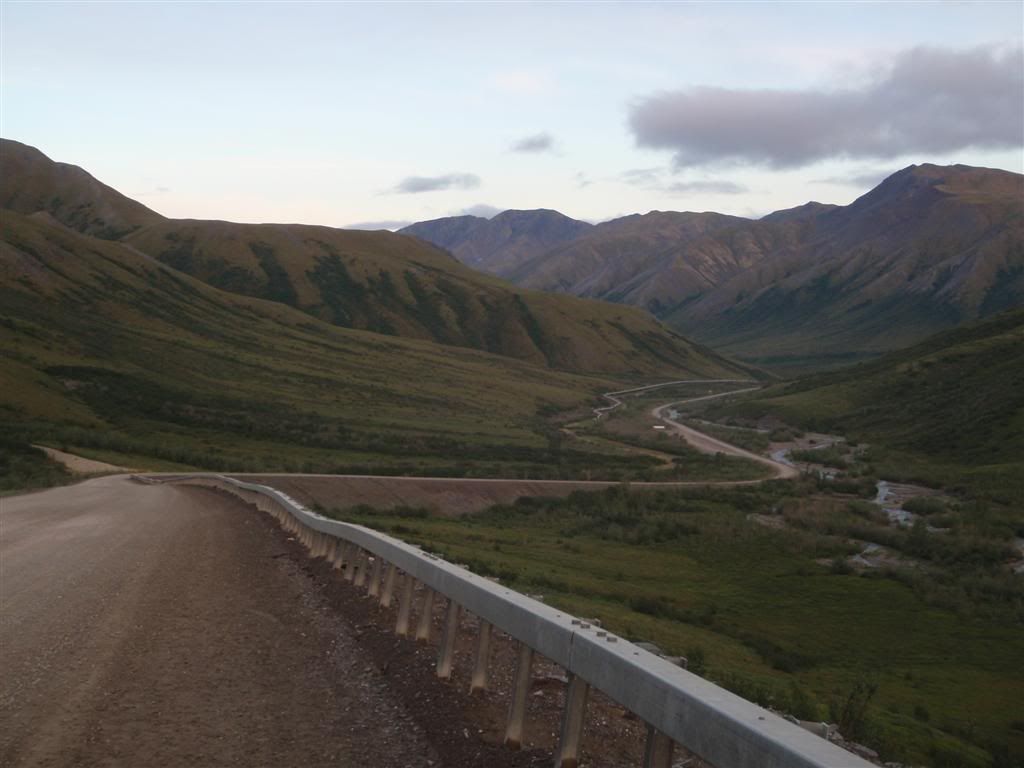
The roads were smooth, the air was clean and dry, although cold, and I was hungry as hell. I got to Coldfoot again at almost 9am. It took me seven hours to go the first 130 miles that day. I was feeling every bit of it.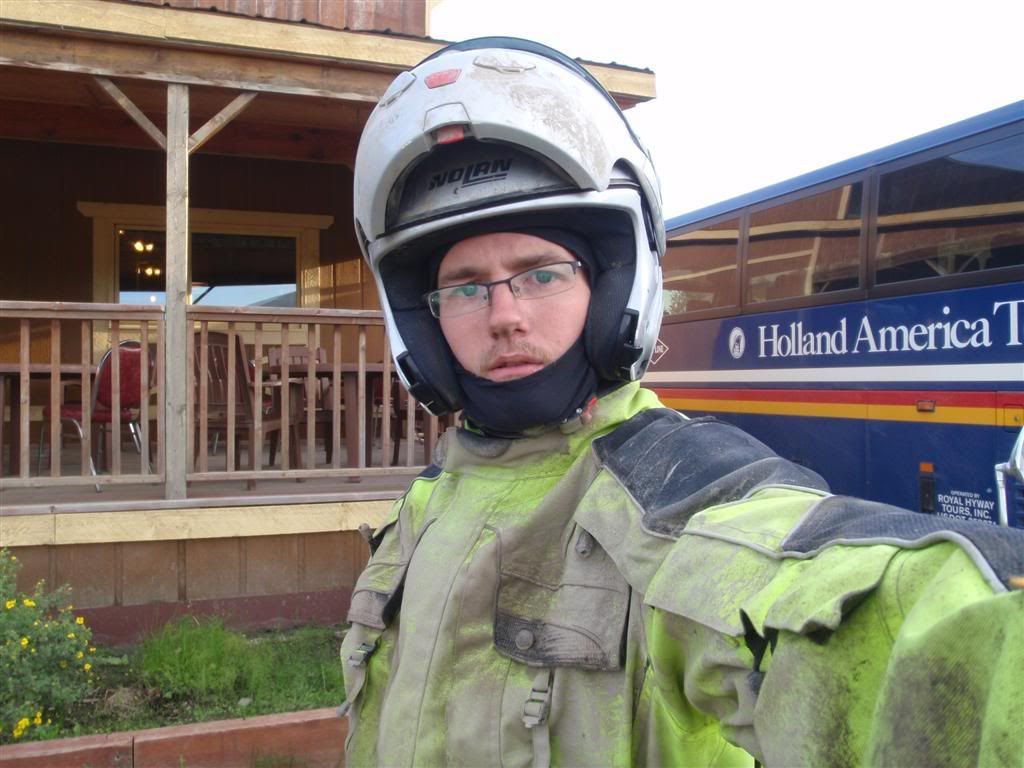
They could have charged $100 for watery oatmeal and cearal and I'd have wolfed it down at this point. But $12 for a breakfast buffet was reasonable enough, and I attacked it with a vengance. I had like six mugs of hot cocco while warming back up.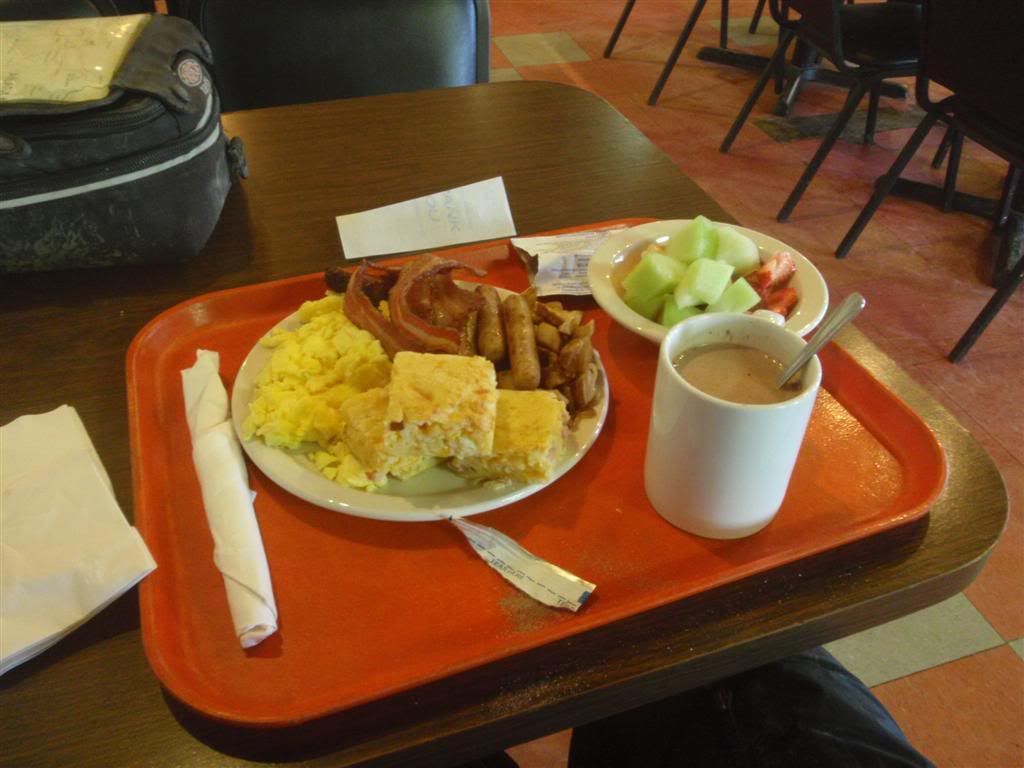
I filled out some more postcards here now that their "Post office" was open. People should be getting them soon, I hope.
The ride south from coldfoot was mostly uneventful. It was what you'd expect; Beautiful mountians, incredible scenery, and smooth asphalt broken only in small places by good gravel or construction. I'll post those pictures later at some point, but I think this post has been long enough. I have a backlog of things from the NWT and Yukon to get through, and I'm behind on my riding even. I've been here in Anchorage for two more days then I thought I would be, and the urge to get back on the road is overpowering.
That was my ride into the Arctic Circle. It won't be my last.
Wednesday, July 15, 2009
The Pipeline Haul Road, part 2.
(if you read the first post before I edited in the extra content, you might want to go back and re-read the post below this one, otherwise this is going to be really out of order)
Subscribe to:
Post Comments (Atom)

No comments:
Post a Comment